After having a good time on the island of Koh Chang and seeing our first wild elephants at Khao Yai National Park, we temporarily left Thailand (we’ll be back after Laos) for Cambodia to visit its famous Angkor temples.
Everyone has heard of these incredible temples. You’ve probably already seen them on screen, as they’ve been the backdrop for several films, including the famous Tomb Raider. Continuing our two-wheeled adventure in Taiwan, we decided to visit the temples of Angkor by bike for 3 days. All in all, an adventure we won’t soon forget! Come on, let’s explain how to visit Angkor temples and share our 3-day itinerary, shall we?
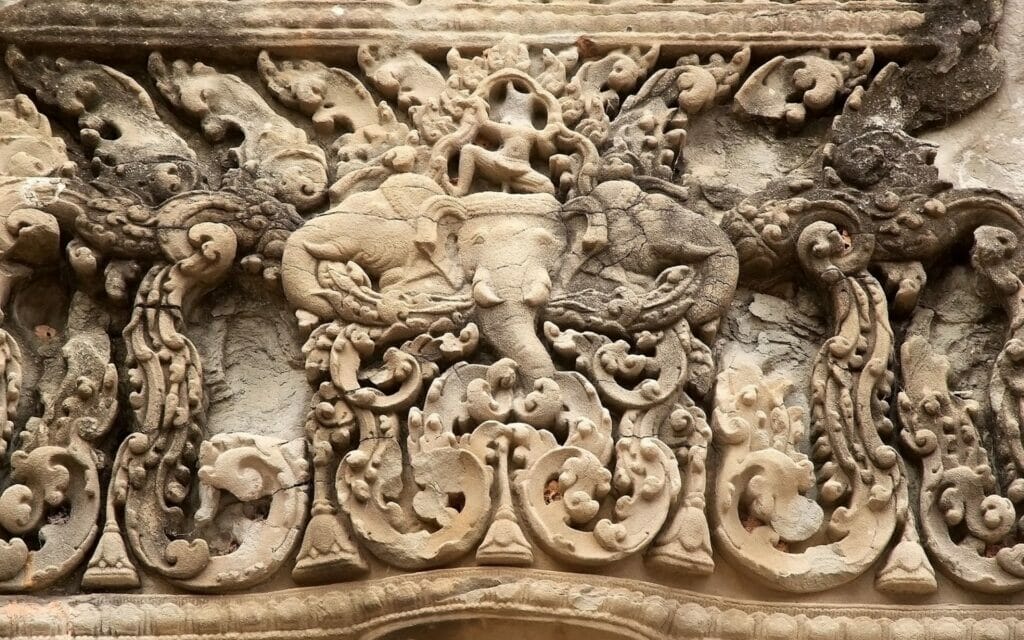
- Introduction to Angkor and Siem Reap
- Video of our visit to Angkor
- How to get to Siem Reap
- Hotels in Siem Reap
- Buy an Angkor temples ticket
- How to get to the temples of Angkor?
- Day 1 in Angkor: the big circuit + Ta Prohm
- Day 2 in Angkor: visiting the more remote temples
- Day 3 in Angkor: the small circuit (Angkor Thom and Angkor Wat)
- A few tips for visiting the temples of Angkor
- Are Angkor temples in danger?
- What to do in Siem Reap besides Angkor temples?
- What to do around Siem Reap?
We took this trip at the end of 2013, but the article was completely revised and updated in July 2023. If you see any price changes or have additional information that might be relevant, please feel free to leave us a comment!
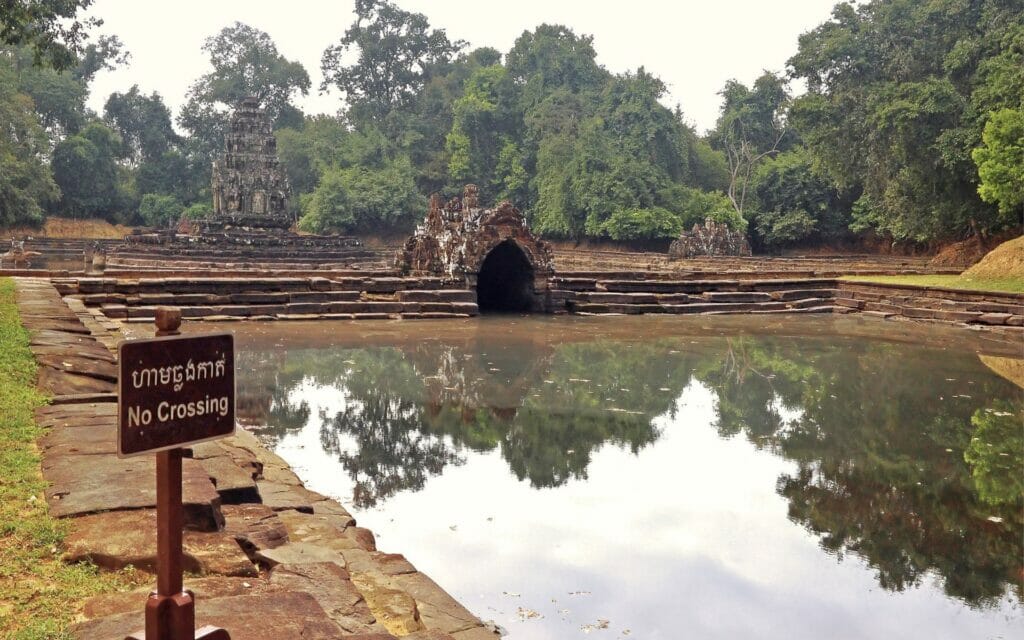
Introduction to Angkor and Siem Reap
The temples of Angkor
So, what exactly is Angkor? Located in the northwest of Cambodia, the city of Angkor stretches over 400 km2 and fascinates… The most famous temple is undoubtedly Angkor Wat (or Angkor Vat), but Angkor is much more than that, and you’ll soon realize it on the spot.
Angkor was the capital of the Khmer kingdom for 5 centuries and was home to 750 000 people. King Jayavarman II founded Angkor in the early 9th century. The remarkable complex of temples and other buildings (canals, reservoirs…) bears witness to the importance of religion and art in Khmer civilization.
To find out more, please refer to the UNESCO article dedicated to Angkor. The city of Angkor has been listed since 1992, as the site was only rediscovered at the end of the 19th century, 400 years after the decline of the Khmer empire!
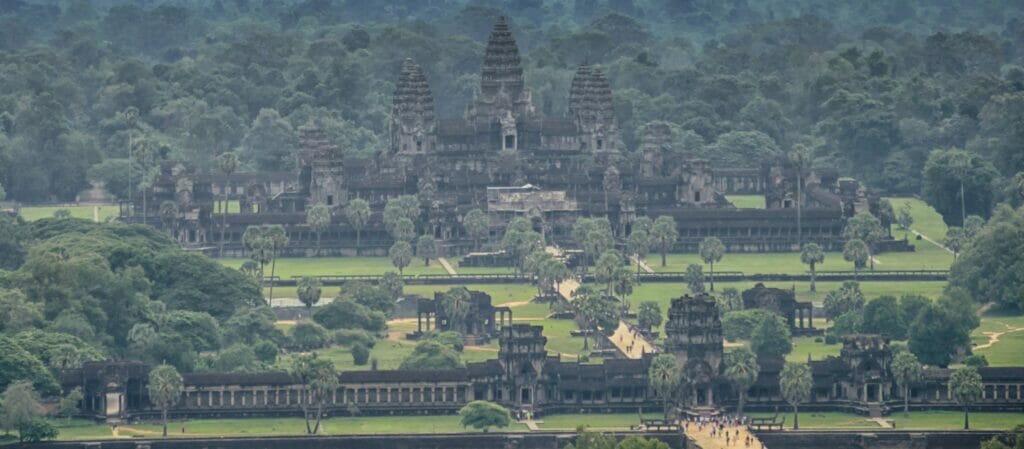
Siem Reap, the hotel town for visiting Angkor
Siem Reap is the gateway to the temples of Angkor: there are 6 km between the town center and Angkor Wat. In the town, the streets are lined with hotels of varying quality, and you’ll be accosted every 30 seconds to see if you need a tuk-tuk. In downtown Siem Reap, you’ll find everything you need to eat, sleep and get around, as well as activities, but nothing transcendent. Everything is concentrated here. Angkor is the country’s number one tourist site, and some travelers only stop off in Cambodia at Angkor before leaving the country!
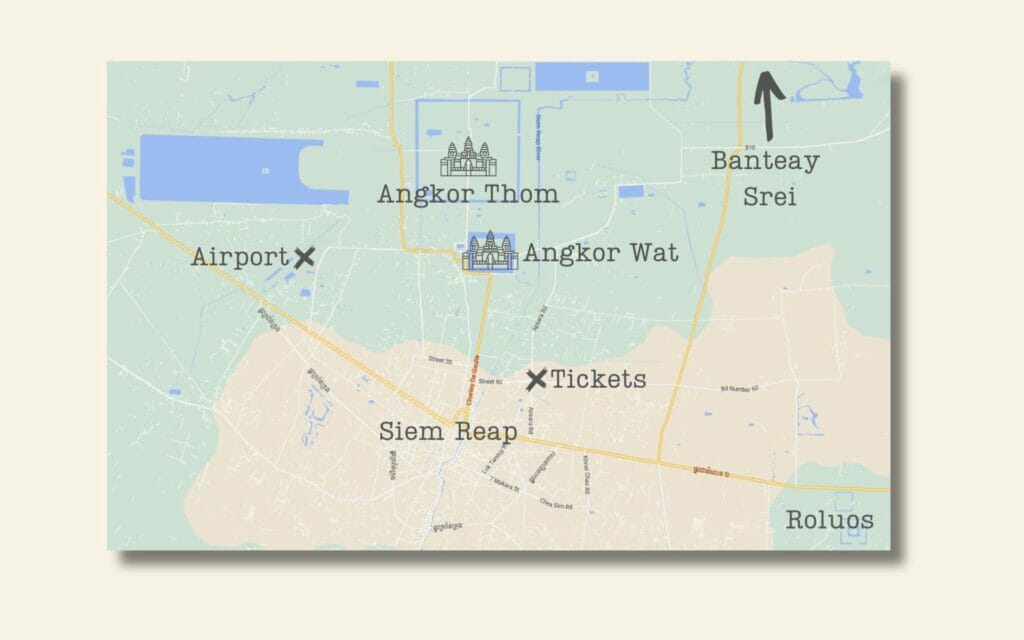
Apart from Angkor, the surrounding area is well worth a visit, and it’s worth exploring to get away from the mass of tourists. See you at the end of this article to discover Siem Reap’s surroundings!
As for prices, as you’d expect, they’re pretty steep! You’ll be hard-pressed to find a double room for less than $10 and food for less than $3. When you consider that the average salary in Cambodia is around $250… To be honest with you, we were pretty happy to leave Siem Reap after 5 days.
Video of our visit to Angkor
Before we get to all the practical information about the temples of Angkor, we’ll give you a taste of what we saw on video! (Psst, we also have a YouTube channel, so don’t hesitate to subscribe!)
How to get to Siem Reap
From the rest of Cambodia
Siem Reap is fairly well served by bus and minivan from all over Cambodia.
From Battambang, the quickest way is to take a minibus that will get you to Siem Reap in 3 hours for around 12 euros.
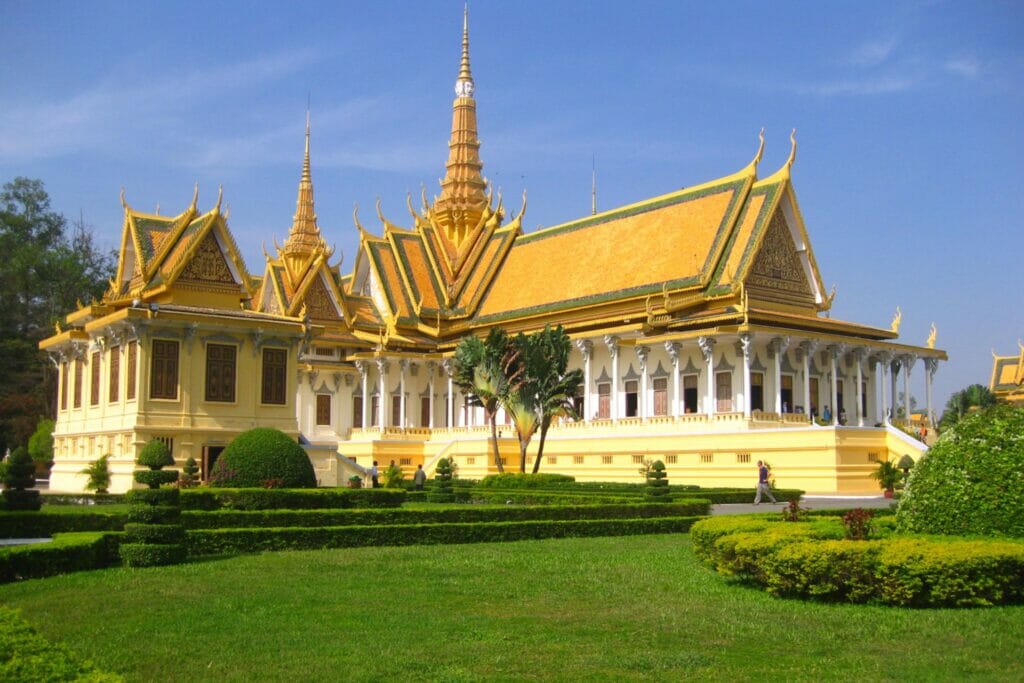
From the capital, Phnom Penh, the bus is the cheapest way to get to Siem Reap. Tip: some buses run at night, leaving around midnight and arriving at 6 a.m., starting at 10 euros. It’s a great way to arrive early, get some rest, take a leisurely stroll around town, and buy tickets for Angkor so you’re ready for the next day! Consult timetables and book your ticket here.
From Bangkok
Worn out by our transport problems across Thailand, we decided it would be better to go back via Bangkok from Khao Yai to reach the border with Cambodia. So we got up early and boarded the first train to Bangkok. Why the train? Because it’s by far the cheapest way to get around Thailand!
In this section, we explain our train journey from Khao Yai National Park to the Cambodian border and on to Siem Reap. But you can also make the Bangkok-Siem Reap journey by bus (8 hrs for around 30 euros) or by plane (for 40 euros); it’s easier because you won’t need to change modes of transport along the way!
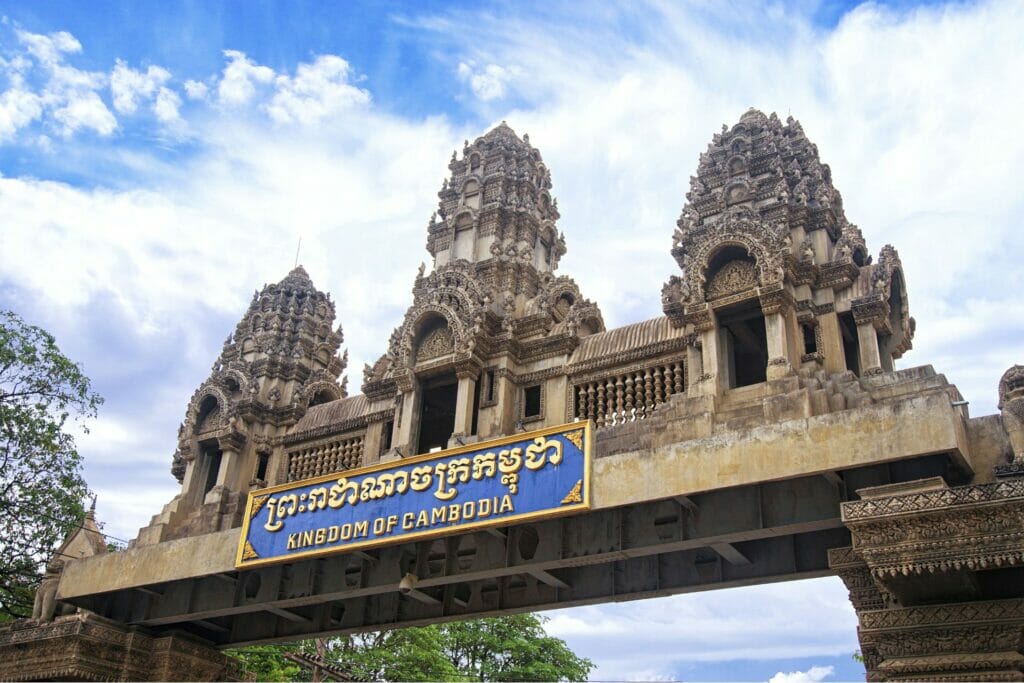
The border at Poipet
Arriving in the capital, we took another train to Aranyaprathet, the terminus station close to the Poipet border post. It’s worth noting that Poipet is the main border with Cambodia, famous for all kinds of scams. Once at the station, we followed the advice we’d found on various blogs.
Then we took a tuk-tuk to Poipet for less than 100 bahts. We buried our heads in the sand to ignore the horde of people who wanted to “help” us with visas. Warning: don’t spend any money until you’ve crossed the Thai border and arrived at point 4 on the map below. We walked to the Cambodian border post, where we paid $30 for the visa (official price) and 100 bahts for the kindness of the border guards (it’s best not to have problems with these people).
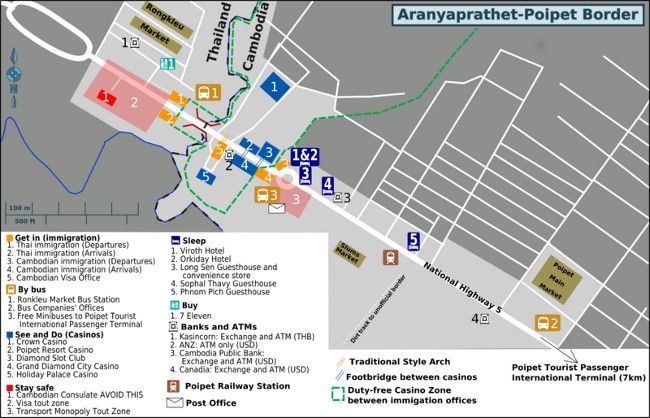
Arrival in Siem Reap
We finally crossed the border without a hitch, handled it beautifully you might say! But that’s when the scams come one after another… It was already past 8 p.m. and we still wanted to get to Siem Reap that evening. So we got together with the last travelers to cross the border (which closes at 8 p.m.) to get a cheap minibus to Siem Reap. After some negotiation, we came up with $10 per person, which didn’t seem too bad. After a 2.5-hour journey, the minibus stops just outside Siem Reap, where an army of tuk-tuks is waiting for us. Damn, we’ve been fooled!
The drivers had agreed to take us to the hotel for free if we accepted their services to visit the temples the next day. But how unlucky, Fabienne and I had planned to do the tour by bike. As a result, they were less cooperative and pretended not to know where our hotel was. Well, for $3, the guy magically regained his memory! In the end, we didn’t do too badly compared with other travelers who crossed the border at Poipet. It’s best to be aware of scams anyway! Still, we ended the day tired and a bit pissed off…
All in all, our trip cost us around 15 euros per person (and a lot of nerves).
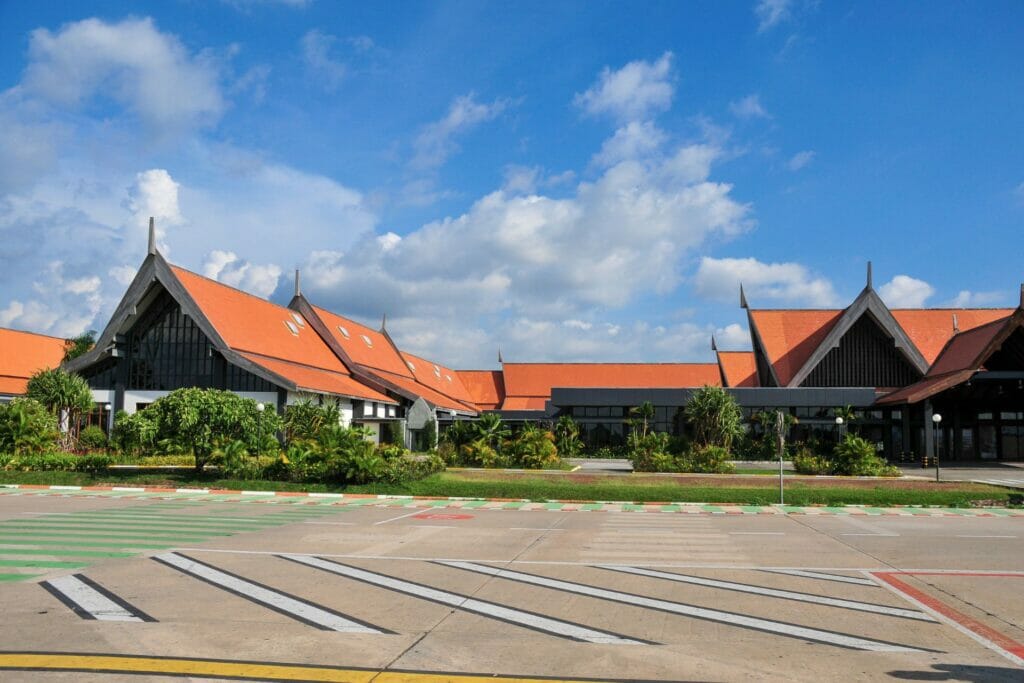
This article contains affiliate links to partner sites. When you use our links to book accommodation, a car, or an activity, you don’t pay anything extra, but we get a small commission. This helps us to offer you free, independent, and ad-free content. Thank you for your support!
From Southeast Asia and Europe
If you’re already in Southeast Asia, the only direct flights you’ll find to Siem Reap are from Bangkok, Hanoi, and Ho Chi Minh.
From the rest of Asia and Europe, you’ll land in Cambodia’s capital, Phnom Penh. From Paris, you’ll find flights from 800 euros return. But we advise you to fly from Paris to Bangkok and then on to Siem Reap, by plane or bus. With an outward journey costing 300 euros and a Bangkok-Siem Reap journey costing less than 40 euros, it’s a lot cheaper!
Once at Siem Reap international airport, taxis and tuk-tuks will be waiting to take you into the town center, 8 km away. You’ll be able to manage for less than $10 a ride. If you’ve already booked your hotel, be sure to check, as some offer a free shuttle to the airport!
A new airport is currently under construction 50 km east of Siem Reap and should be operational by the end of 2023. The old one, to the west of Siem Reap, is due to close…
Hotels in Siem Reap
We arrived at the hotel at 11.30 p.m., after a 10-minute drive. We hadn’t made a reservation, but we already knew the price of a hotel room ($10). At the reception, the guy said: “It’s $12 for the cheapest room”. I reply: “But on Hostelworld, the room is $10, and on your website, it’s $7. That’s not right!”. I’ll spare you the rest of the slightly less polite dialogue. Given the late hour, the guy knew we didn’t have much choice and we ended up taking the $12 room. We simply played the dumbs the next day: we checked out and then checked in again after reserving the $10 room online…
You’ll tell us that we may be nitpicking for a few dollars, but it’s the kind of thing that gets tiresome in the long run. What’s more, the manager didn’t exploit it very well, so we didn’t feel much like buying from him… But that’s the way it is!
As Siem Reap is quite spread out, we advise you to take a hotel in the city center or the north of Siem Reap so as not to lengthen the journey if you decide to visit Angkor by bike 😉. Here are the accommodations that offer the best value for money (+ an extra to treat yourself):
- The Flex Hostel: the price of this hostel can’t be beaten, $2 a night in a dormitory! But be warned, here, a low price doesn’t mean a bad experience… Plus, you have access to the pool! In short, enough to balance your Angkor budget.
- The Place Hostel: another well-located hostel with its own restaurant. The price is very reasonable too: 6 dollars a night in a dormitory with a swimming pool included!
- Bunyong Homestay: a bed and breakfast 3 km from Angkor Wat for an authentic stay where meals (dinner and breakfast) are taken with the family.
- Mango Kesararam: this charming hotel with its lovely swimming pool is extremely well located. Bonus: we can pick you up/drop you off free of charge at Siem Reap airport!
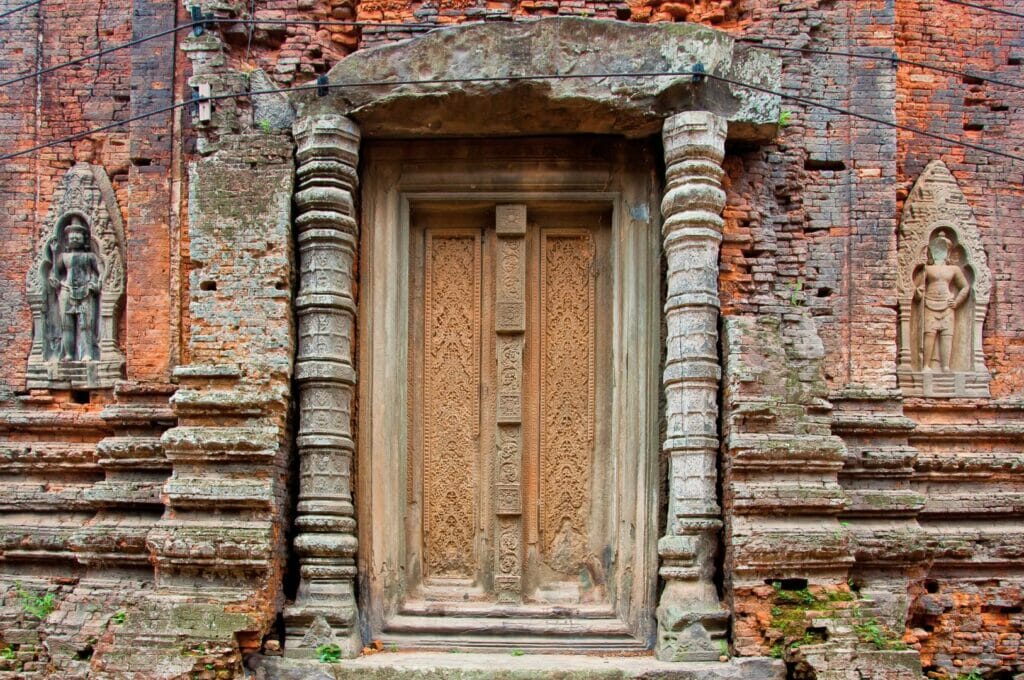
Buy an Angkor temples ticket
The different Angkor passes

There are 3 ticket options for visiting Angkor:
- the 1-day pass at $37;
- the 3-day pass (consecutive or not) at $62, valid for 10 days;
- the 7-day pass (consecutive or not) at $72, valid for 1 month.
How many days to visit Angkor?
Many tourists opt for the one-day pass (especially if they’re on a package tour), but it’s impossible to see everything, let alone take full advantage because of the crowds. We recommend the 3-day pass. As it’s valid for 10 days, there’s no need to get up early 3 days in a row to enjoy the sunrise over Angkor Wat! It also gives you a day off to relax in the hotel pool, explore the surrounding area and avoid temple saturation! We, therefore, recommend staying at least 4 days in Siem Reap.

Where can I buy tickets to visit Angkor temples?
To buy the famous passes that will give you the right to enter the city of Angkor, you have the choice between buying them at the ticket office or online. In all cases, be sure to indicate the first day you wish to visit Angkor and not the day you arrive in Siem Reap, otherwise, you’ll miss a day. Passes are named, and a photo will be taken (or requested if you buy online) to affix to your pass. Keep them with you at all times, as you’ll be asked for them regularly.
In Siem Reap
The ticket office is located 4 km east of Siem Reap town center, at the junction of 60 Street and Apsara Road (see map above). Please note that we’ll read there is another place to buy passes on Charles de Gaulle Street in the north of town, but it has been closed for several years now!
The ticket office is open every day from 5 a.m. to 5.30 p.m., and you can pay in dollars or by credit card. Note: if you arrive in Siem Reap shortly before 5 p.m. (not like us), get your 3-day pass for the next day’s visit right away to avoid wasting time at 5 a.m. By the way, if you do this, you’ll be able to watch the sunset over Angkor Wat for free after 5 p.m. on the same day! Please note that before 5 p.m., your 3-day pass will start the same day instead of the following day. So there’s no need to buy your pass at 2 p.m.
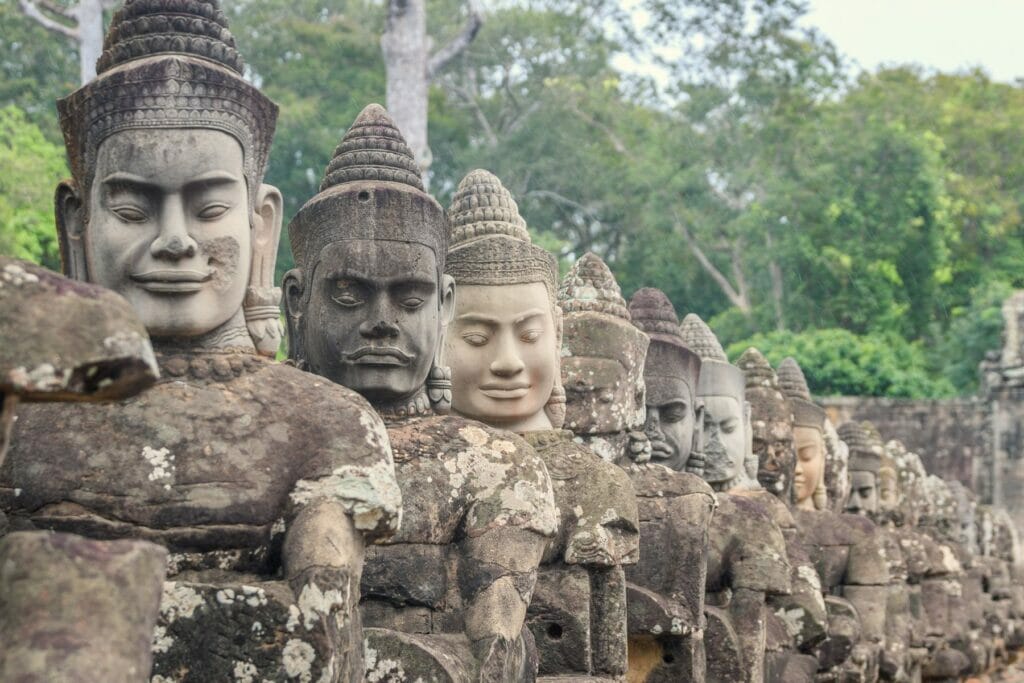
Online
It has recently become possible to buy your Angkor tickets online, on the government website. (Beware of other websites issuing invalid passes) The process is simple: select Angkor, then indicate the first day of your visit. You will then be asked to provide information (nationality, gender, ticket category) and to upload a photo of yourself (ID photo or selfie with your face clearly visible).
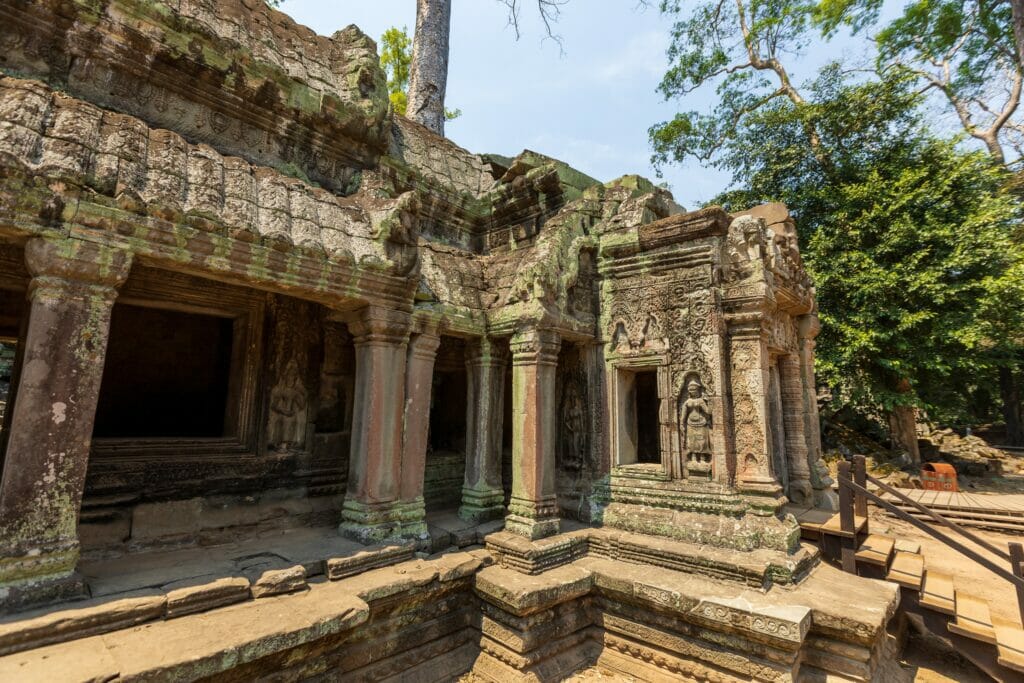
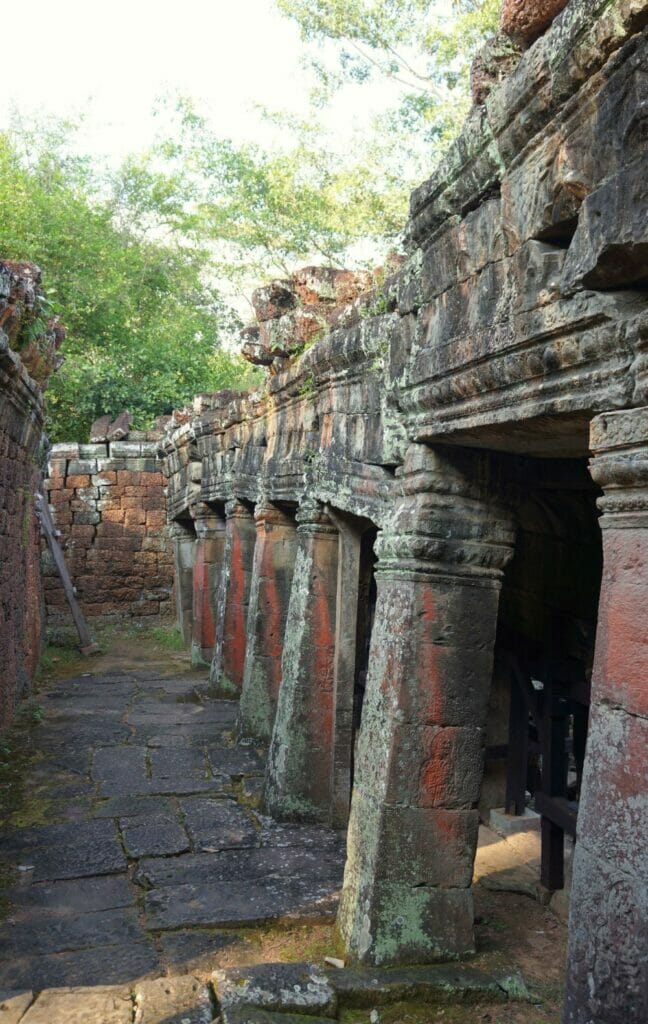
How to get to the temples of Angkor?
Angkor temples are open every day from 5 a.m. to 5.30 p.m., but there are exceptions! Angkor Thom only opens at 7.30 a.m., but you can still cross the site (in principle) to get to Preah Khan and be the first to visit. Preah Khan, Pre Rup and Banteay Srei, further afield, are also open at 7.30 a.m.
Visit Angkor temples by tuk-tuk
The tuk-tuk is the most practical and popular way to visit Angkor. But it’s not the cheapest (at least $15 a day), and it’s not the way to get off the beaten track. In other words, if you don’t tell the driver clearly what you want to do, you’ll still be following the crowd as they follow a well-defined route.
As mentioned above, you’ll have no trouble finding a tuk-tuk driver to take you around the temples of Angkor. They’ll come to you as soon as you set foot in Siem Reap. Normally, they’re all English-speaking, and some are more informative than others. We suggest you to contact Kim, the first female tuk-tuk driver in Angkor! She’ll be delighted to accompany you as you explore the city of Angkor and give you all the explanations you need on the spot!
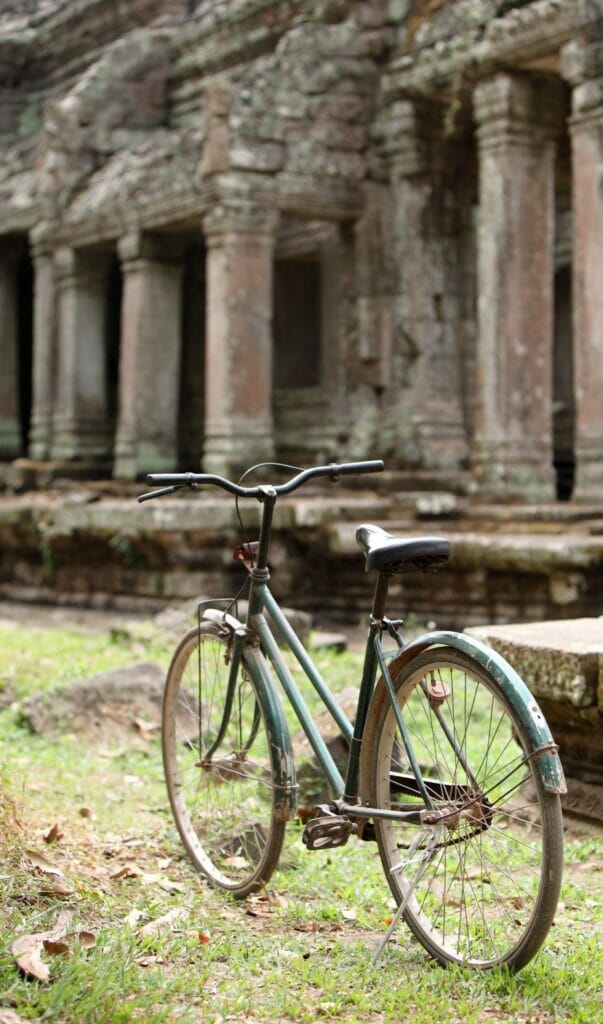
Visit Angkor by bike
Many people will tell you that you can only visit Angkor by tuk-tuk, but that’s not true! It’s perfectly possible to visit the temples of Angkor by bike, and that’s how we explored the site! Expect to pay around $5 per day per bike. Given the price of admission to the temples, it doesn’t hurt to save a little on transport!
OK, the site is pretty big, but the roads are in good condition and completely flat. Of course, if you don’t feel like cycling under the sun, that’s understandable! But if you are tempted by the adventure, don’t be put off by people (hotel managers and tuk-tuk drivers in particular) who will tell you that it’s hell to do it by bike. We’ve tried it, and it’s really easy.
You’ll also find electric bikes/motorbikes for hire in Siem Reap (around 10 dollars/day) to take it easy in the heat. Please note that it is forbidden to enter the compound with regular, i.e. non-electric motorbikes.
Walking around Angkor
It may be a bit intense, but it’s doable for at least a day. Take a tuk-tuk to the gates of Angkor Wat and enjoy the day at leisure in Angkor Vat and Angkor Thom, and leave after sunset. This can be a great alternative for a slow-paced visit away from the crowds.
Angkor temples map: the small circuit and the big circuit
You’ll notice that we got up early to start the tour, and it wasn’t because of the heat! This gives us a head start on the many tourist-filled buses, minivans, and tuk-tuks that converge from Siem Reap every day. (So I won’t get into the question of whether it’s good or bad to have such a mass of people visiting Angkor, I’ll leave that for you to discuss at the end of the article.)
In any case, it’s good to have a strategy in your itinerary for enjoying the Angkor temples almost on your own. But before we reveal our technique, here’s a little map of Angkor to give you an idea of the city as a whole.
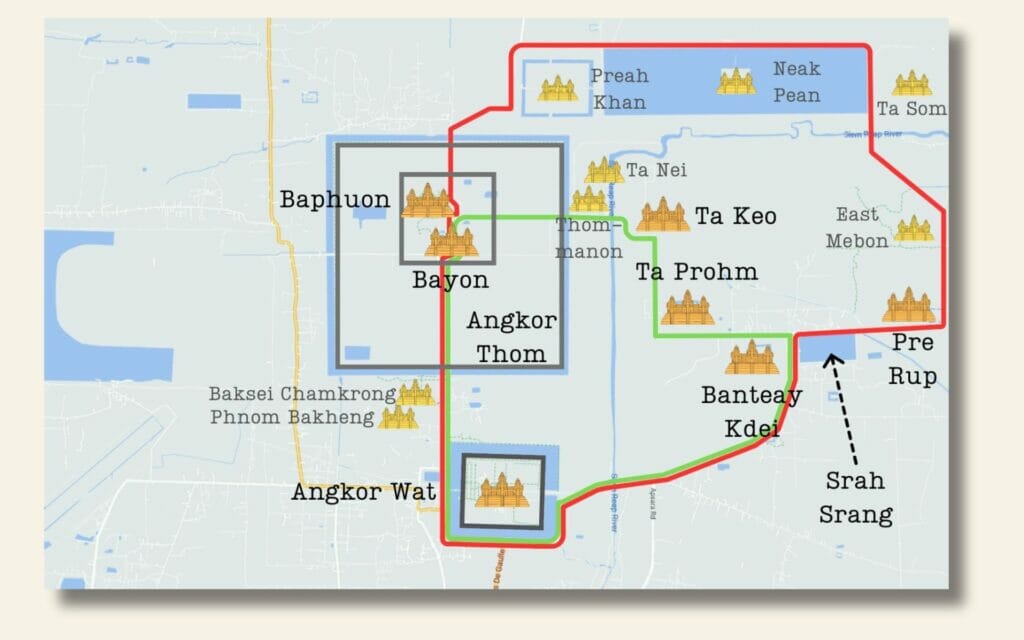
See the green line? That’s the small circuit, the most popular itinerary to visit Angkor. People with a one-day pass stay start with Angkor Wat, then the Bayon in Angkor Thom, Ta Keo and finish the loop with Ta Prohm and Banteay Kdei. The red route, therefore, corresponds to the big circuit of Angkor.
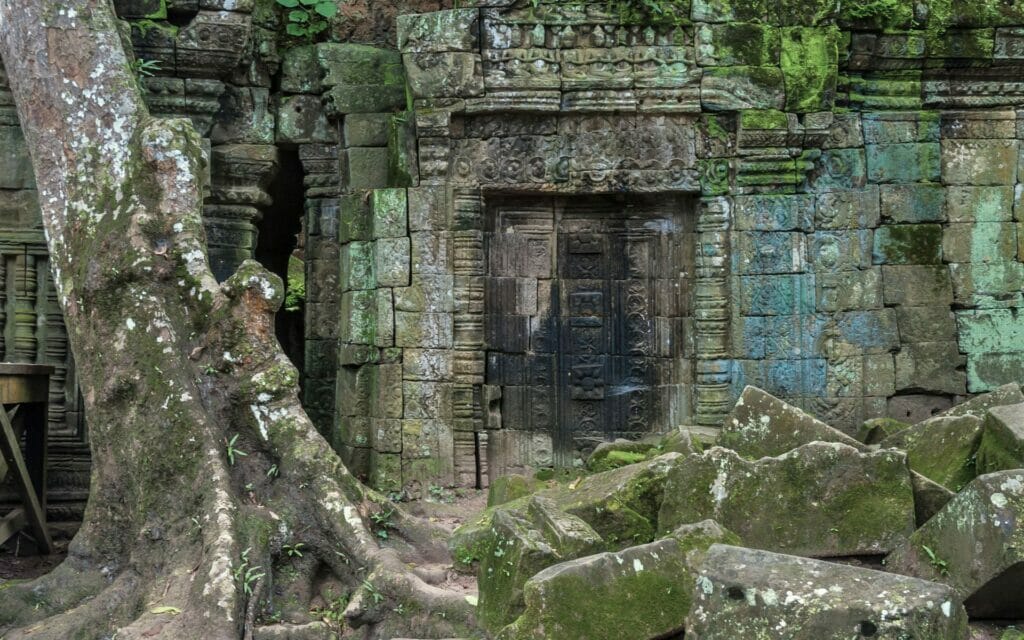
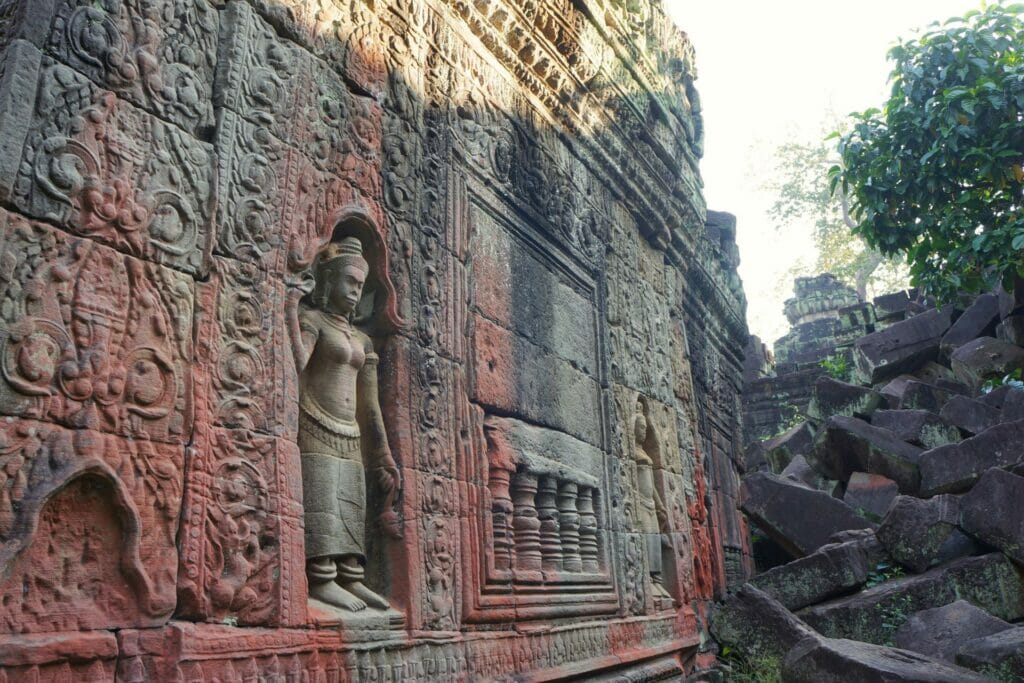
Day 1 in Angkor: the big circuit + Ta Prohm
After a well-deserved day’s rest, we’re up bright and early (6 a.m.) and off on our 2 super mountain bikes to discover one of the world’s most beautiful sites. On the first day of our itinerary in Angkor, we did most of the big tour, skipping the sunrise and sunset. Nevertheless, they can be incorporated into the day if you wish (and if you’ve bought your passes the day before). We’ll tell you about the different spots in Angkor where you can watch the sunrise and sunset a little lower down.
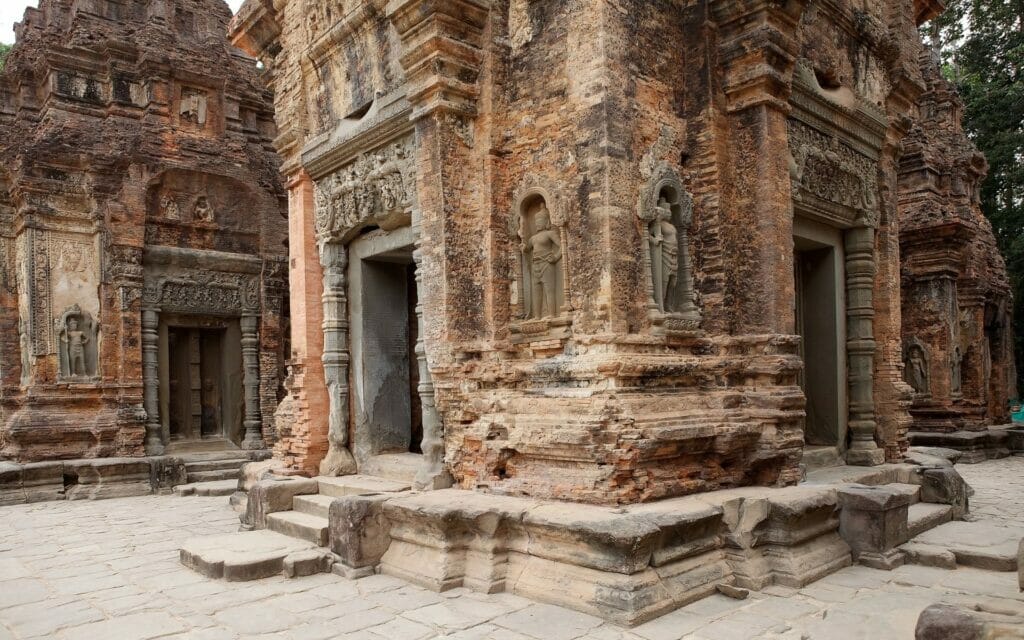
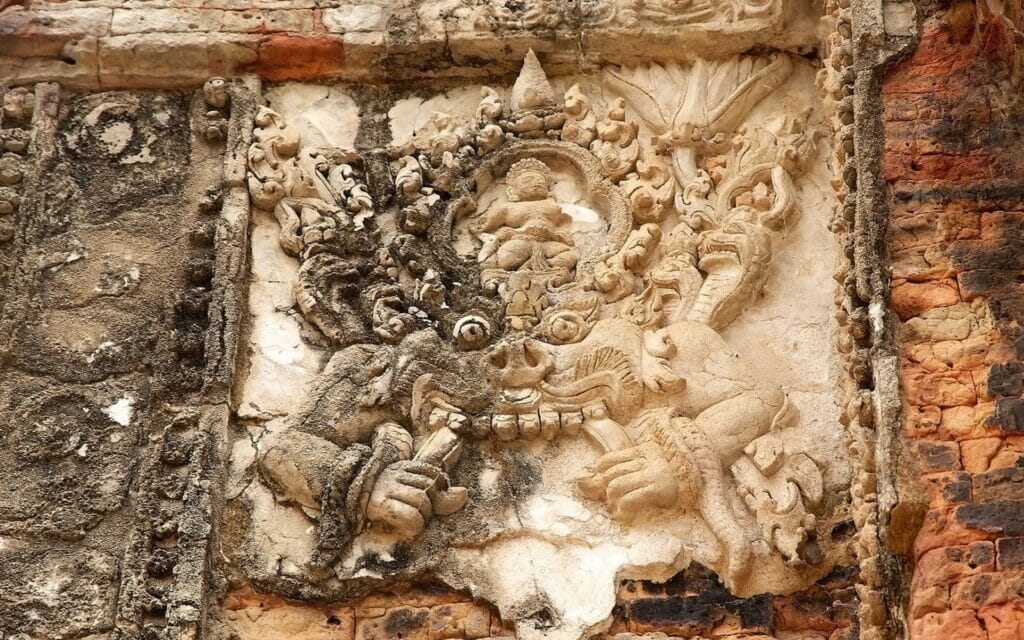
Preah Khan temple
Start directly at Preah Khan temple, voluntarily skipping Angkor Wat and Angkor Thom temples, even if it’s a bit difficult to pass by without stopping! This way, you’ll be one step ahead of all the other people who got up to see the sunrise at Angkor Wat, and who will go on to see the Bayon in Angkor Thom.
Then take your time to visit all the smaller temples that follow one another on the big circuit (drawn in red) to the east: Neak Pean (a rather singular temple in the middle of an expanse of water), Ta Som, East Mebon, Pre Rup, Banteay Kdei, and so on.

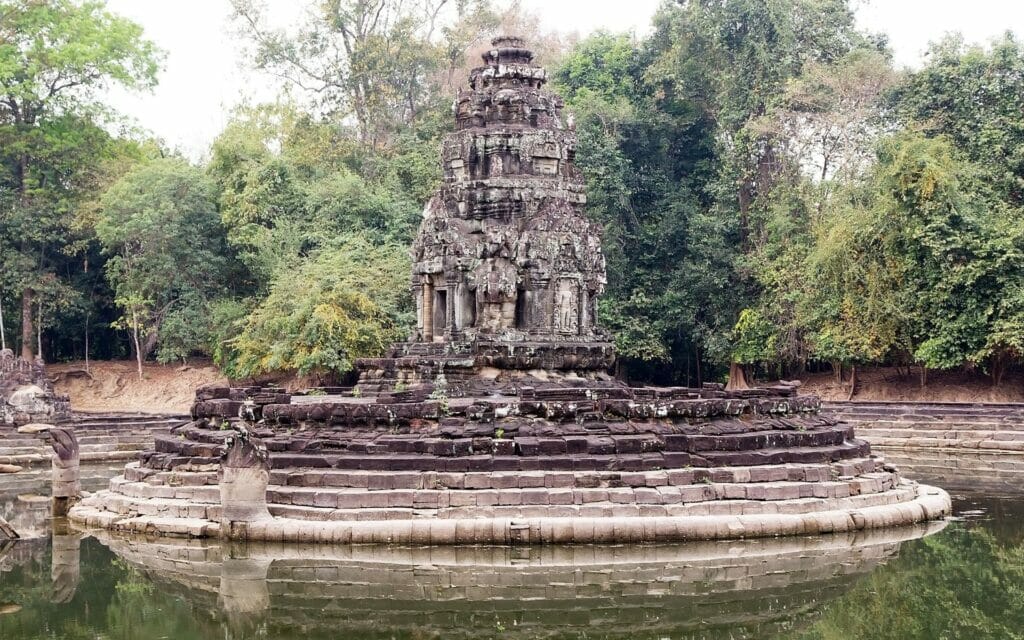
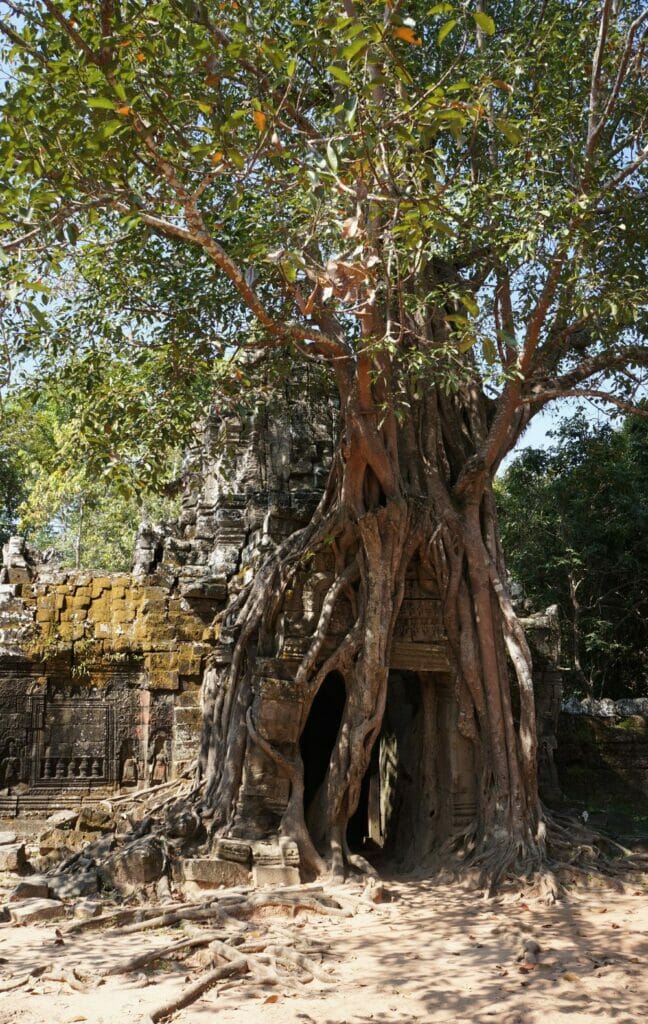
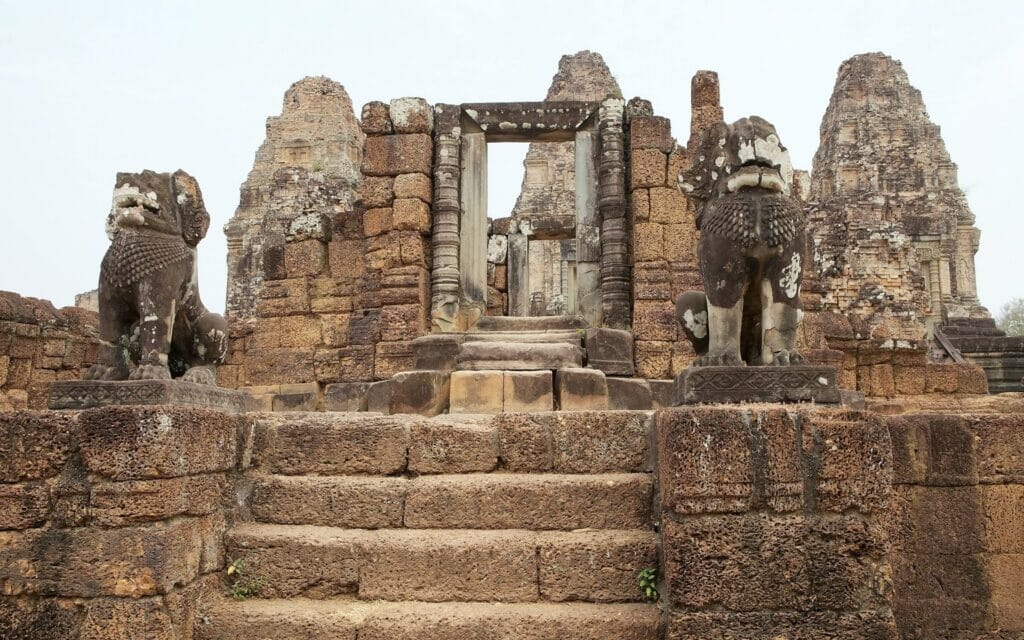
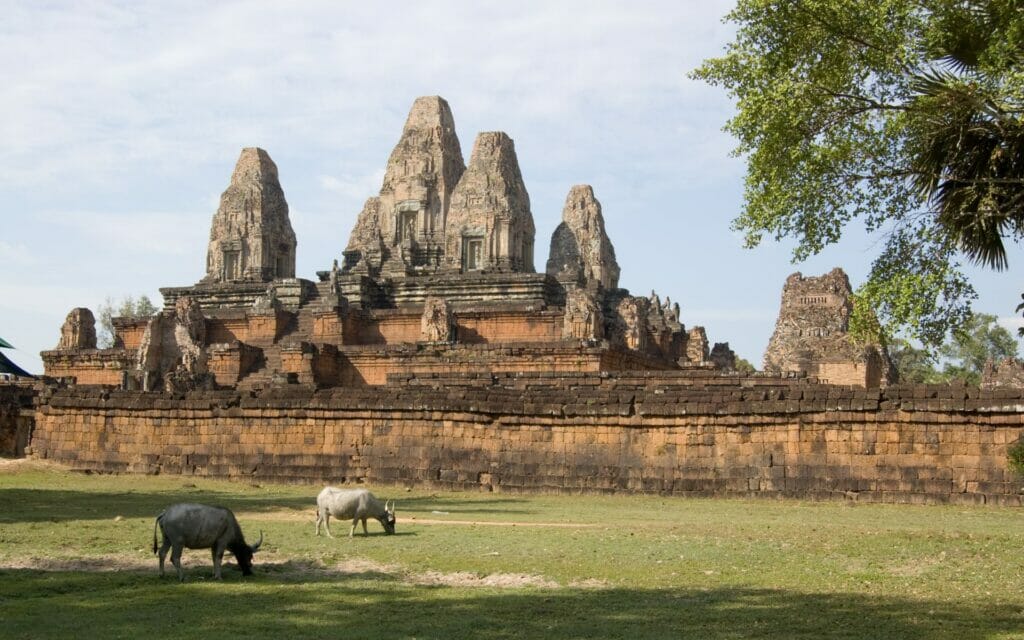
Ta Prohm
In the afternoon, set off to discover Ta Prohm, a most impressive sight. The vegetation has invaded the site, literally plunging you into the world of Indiana Jones (or Tomb Raider) movies. I felt like a kid! Deliberately lose yourself in the nooks of the temple (it’s bigger than it looks) and simply enjoy the beauty of the site.
If you want to enjoy the sunset, save Ta Prohm and Banteay Kdei for the third day in Angkor, after visiting Angkor Thom.
If you decide to cycle, allow between 40 and 45 km for your first day in Angkor.
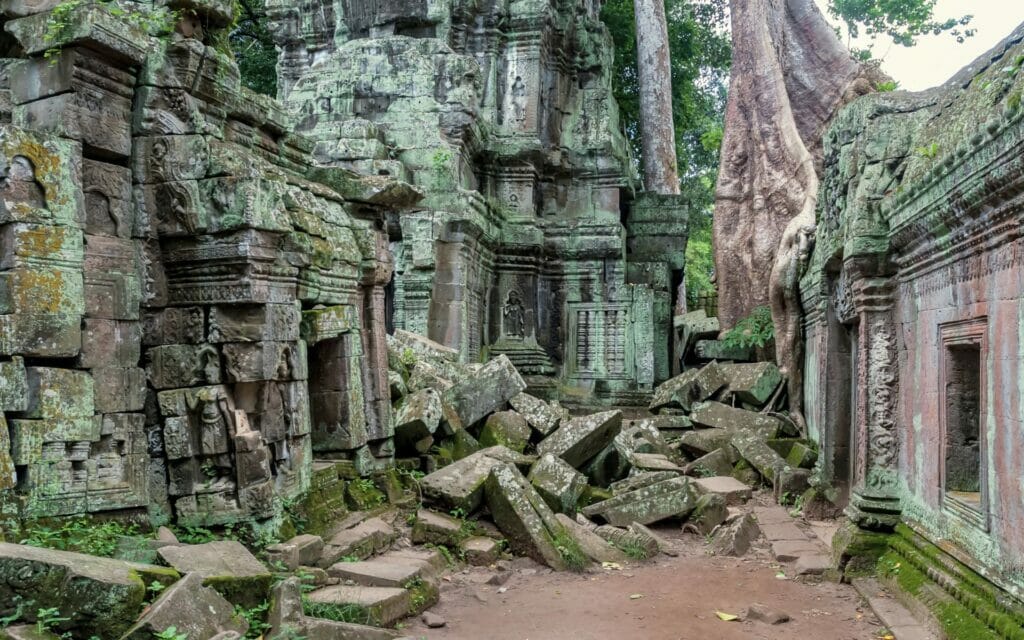
We deliberately skipped the sunset, as we were only there for 3 days. However, if you can make it out on the first day, go for it! Here are the best spots to watch the sunset in Angkor:
- around Angkor Wat: as with sunrise, the Angkor Wat enclosure is a must-see spot to catch the last light of day;
- Phnom Bakheng temple: situated on a small hill, Phnom Bakheng allows you to take a step back and watch the light slowly fade;
- at the Srah Srang reservoir: thanks to the reflection of the last rays on its surface, the Srah Sang reservoir can be a good photo spot on your 3 days in Angkor;
- further, from Phnom Krom temple: some twenty kilometers south of Siem Reap, the hill of Phnom Krom temple overlooks rice paddies and Tonle Sa Lake, making it a great spot for sunsets! Access to the temple is included in your Angkor pass.
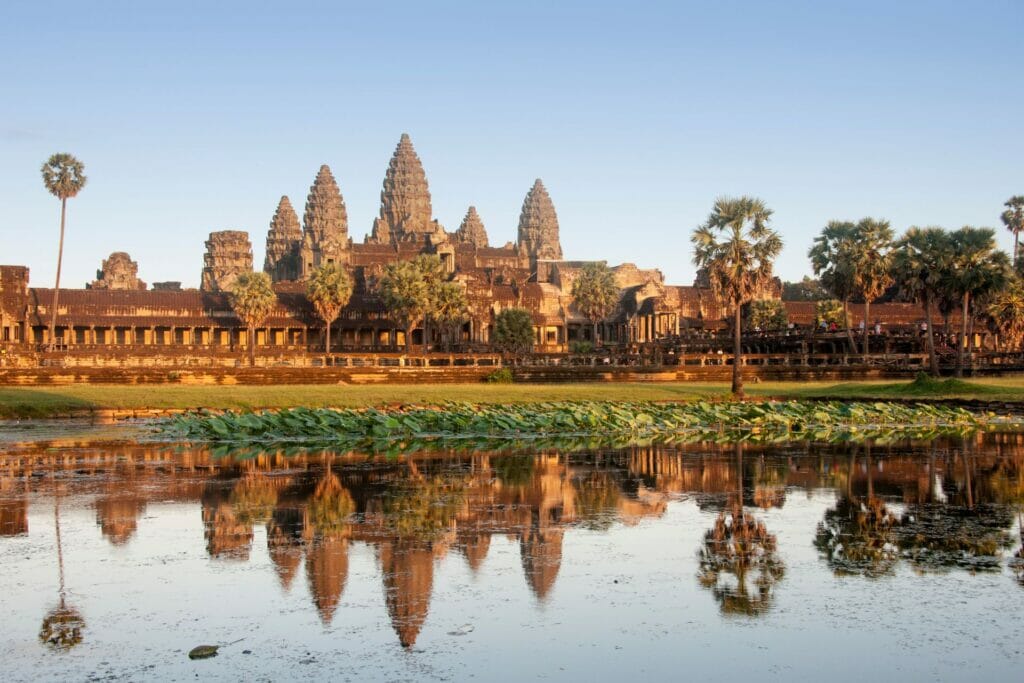
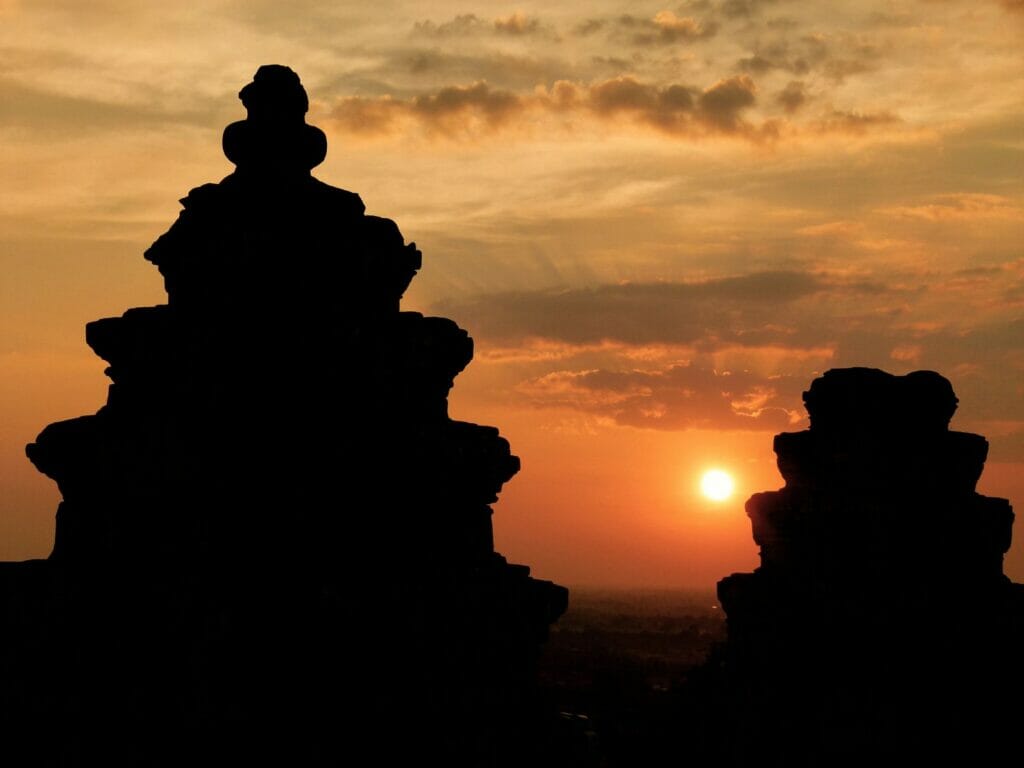
Day 2 in Angkor: visiting the more remote temples
Day 2 in Angkor is stress-free. After all that exploring the day before, you’ve earned a break to prepare for the next day! We’ve opted for the Roluos temples, but we’ll explain the other possibilities.
Roluos archaeological complex
Located around 15 km east of Siem Reap, the Roluos temples are a must! You can get there by bike, as we do, but be careful of the traffic on the road. Otherwise, rent a scooter or take a tuk-tuk to get there. Entrance to Roluos is included in the Angkor pass, and you should allow half a day to visit the entire site.
Formerly Hariharalaya and the first capital of the Khmer empire, Roluos was built before the city of Angkor, at the end of the 9th century! The complex comprises several temples, including 4 main ones: Bakong, Preah Ko, Prei Monti, and Lolei.
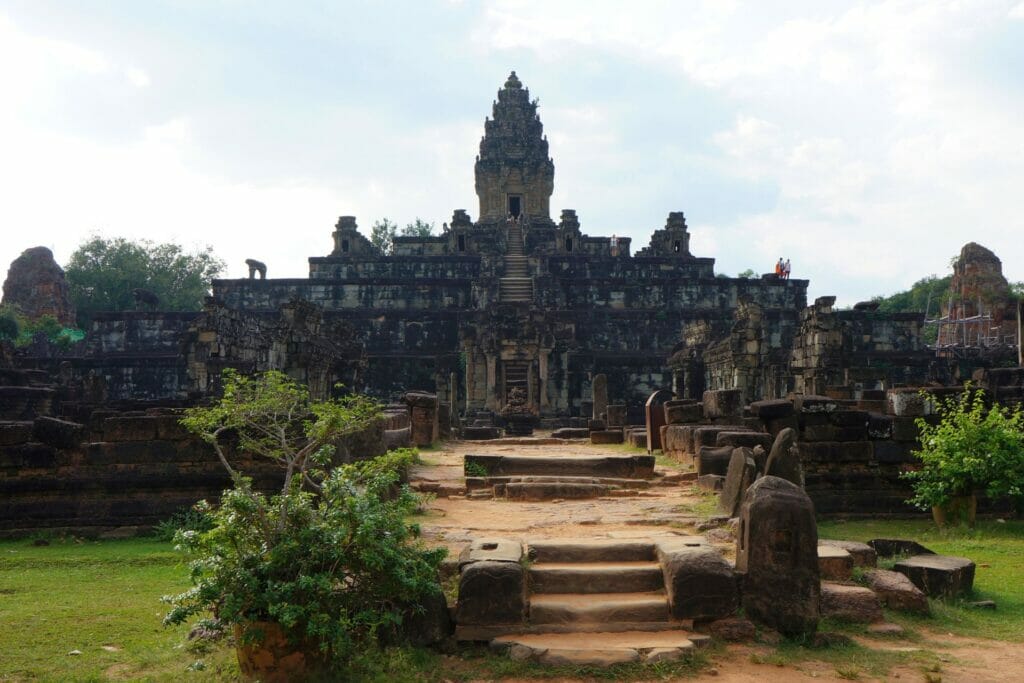

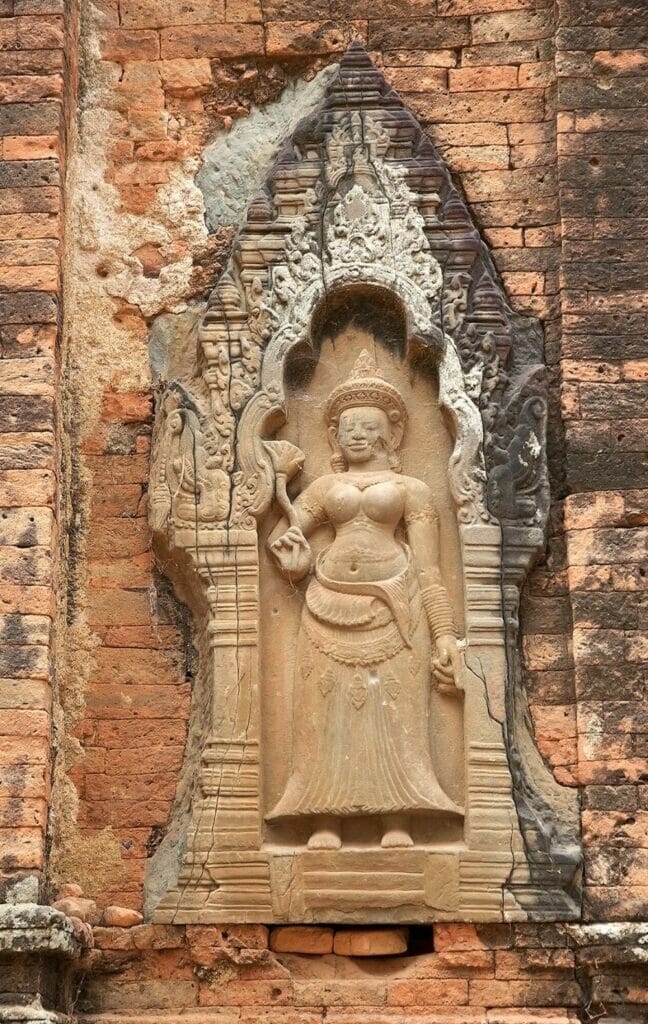
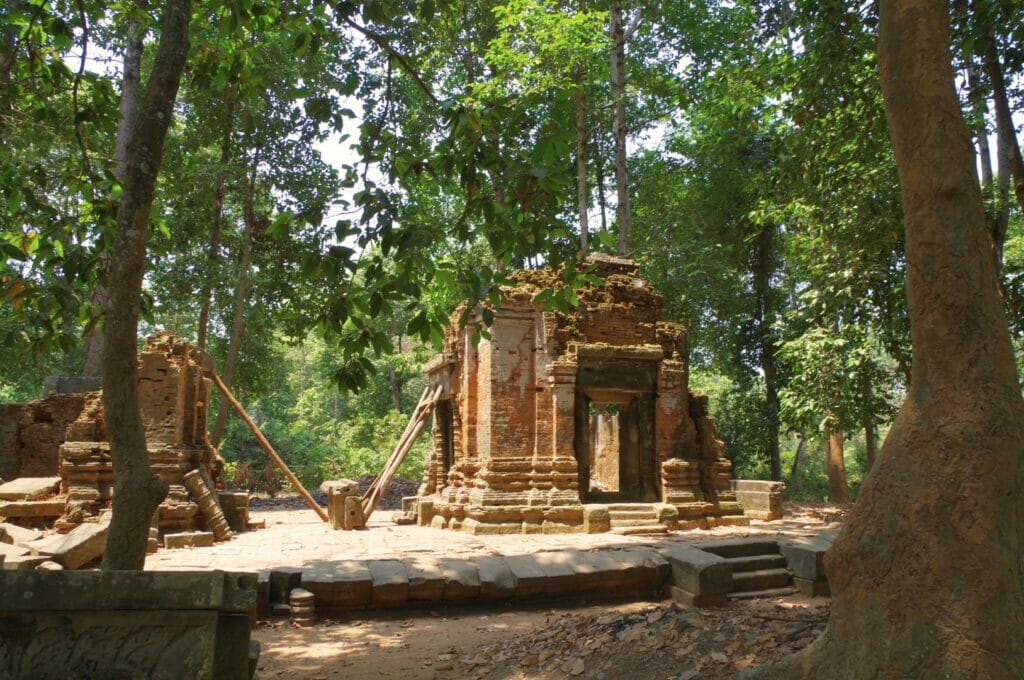
Banteay Srei
An alternative is to visit Banteay Srei and its pink stones, 1 h north of Siem Reap. Here, motorbikes and tuk-tuks are more than welcome! We didn’t go, but it’s hard to miss… (Perhaps we should have opted for Banteay Srei rather than Roluos!?) Entrance is included in your Angkor pass.
Known as the citadel of women or the pink temple, Banteay Srei is a little jewel of refinement. The pink sandstone walls of this small temple dedicated to Shiva are magnificently sculpted. This is the only temple in Angkor which not built by a monarch, it was built by 2 courtiers.
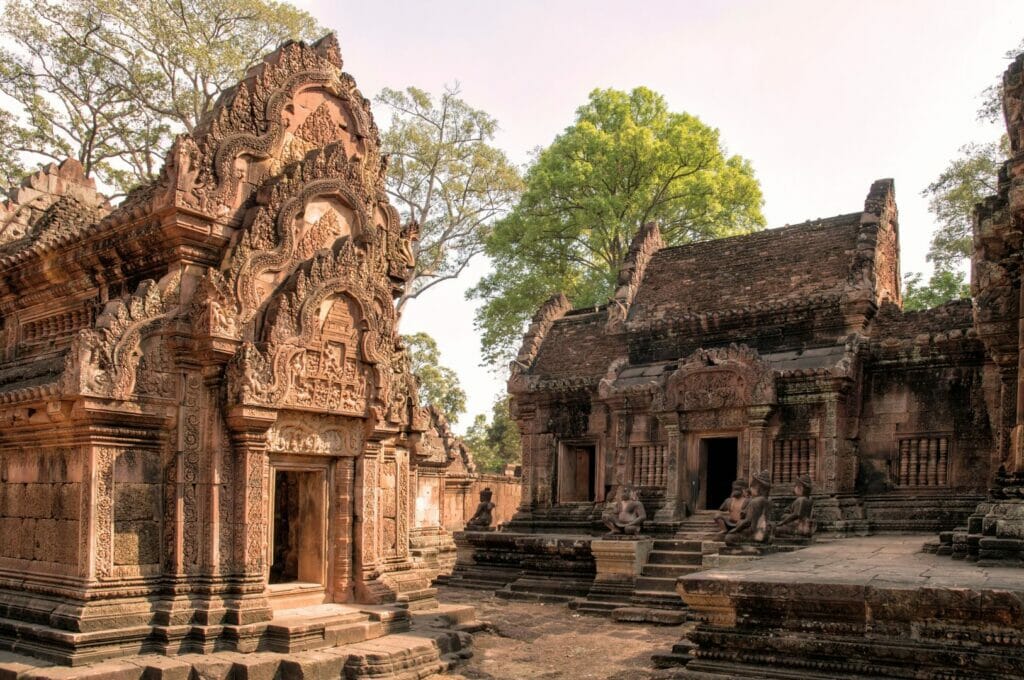
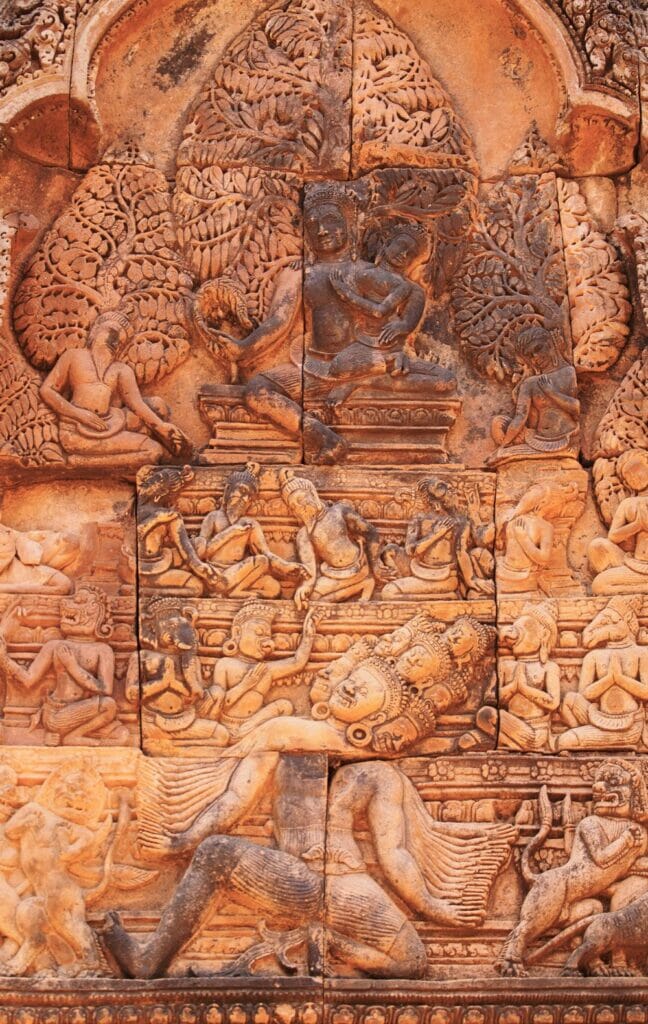
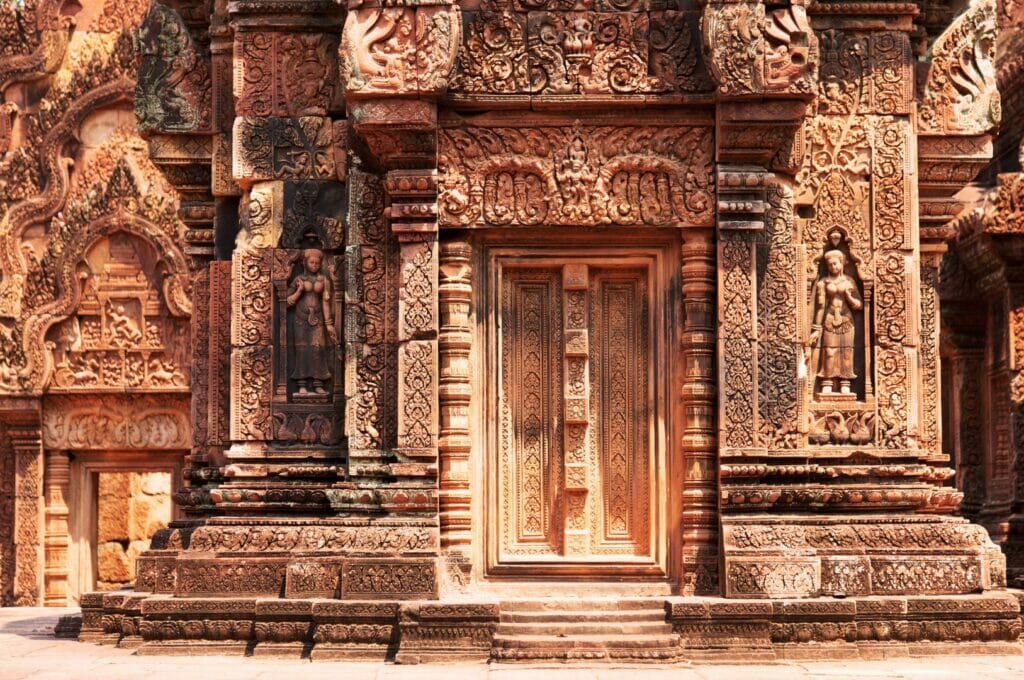
Kbal Spean
Another option for this second day is to combine Banteay Srei and Kbal Spean. We’ve heard great things about both! 15 minutes north of Banteay Srei, you’ll discover the River of 1000 Lingas, an archaeological site where the riverbed is superbly sculpted, all in the heart of the jungle! The price is included in the Angkor pass.
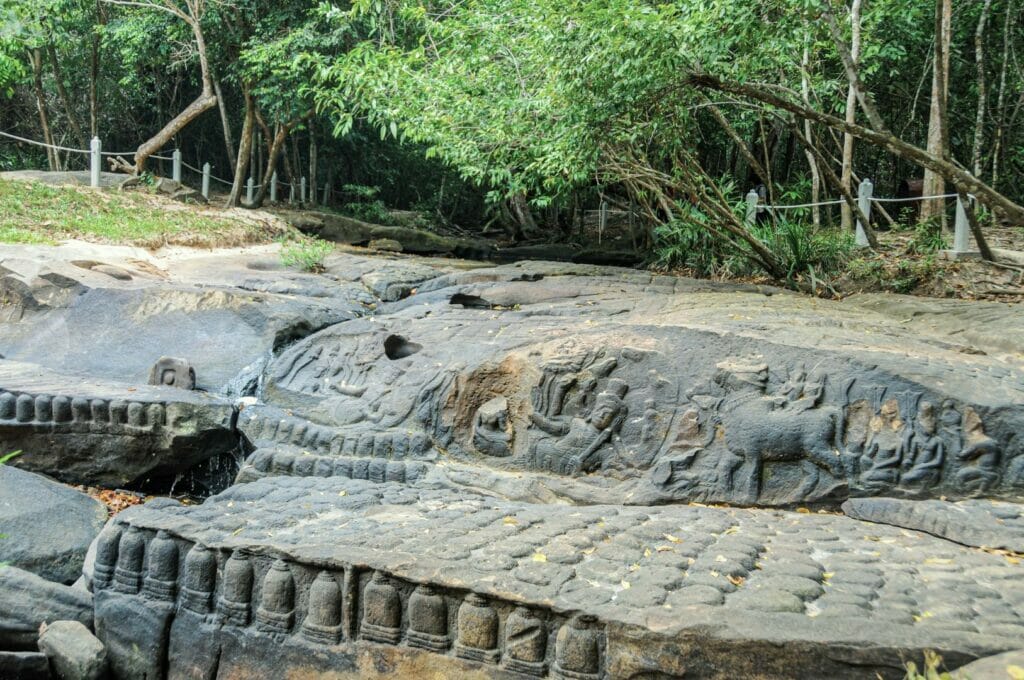
Day 3 in Angkor: the small circuit (Angkor Thom and Angkor Wat)
Ready for your last day in Angkor? This is the day of the itinerary that hurts a bit because you’ll have to set your alarm clock for 4.30-5.00 a.m.! But we promise you won’t regret it!
Sunrise over Angkor Wat
Go at 5.30 a.m. for sunrise over Angkor Wat. If you’re doing it by bike, don’t forget your flashlight. We warn you: it’s going to be very crowded! But, strangely enough, people hurry inside the Angkor Wat enclosure, to the level of the basin on the left. But if you stay to the left of the bridge, at the entrance, you’ll have a much quieter time, and be treated to incredible reflections on the water surrounding the temple. I think the photo speaks for itself…
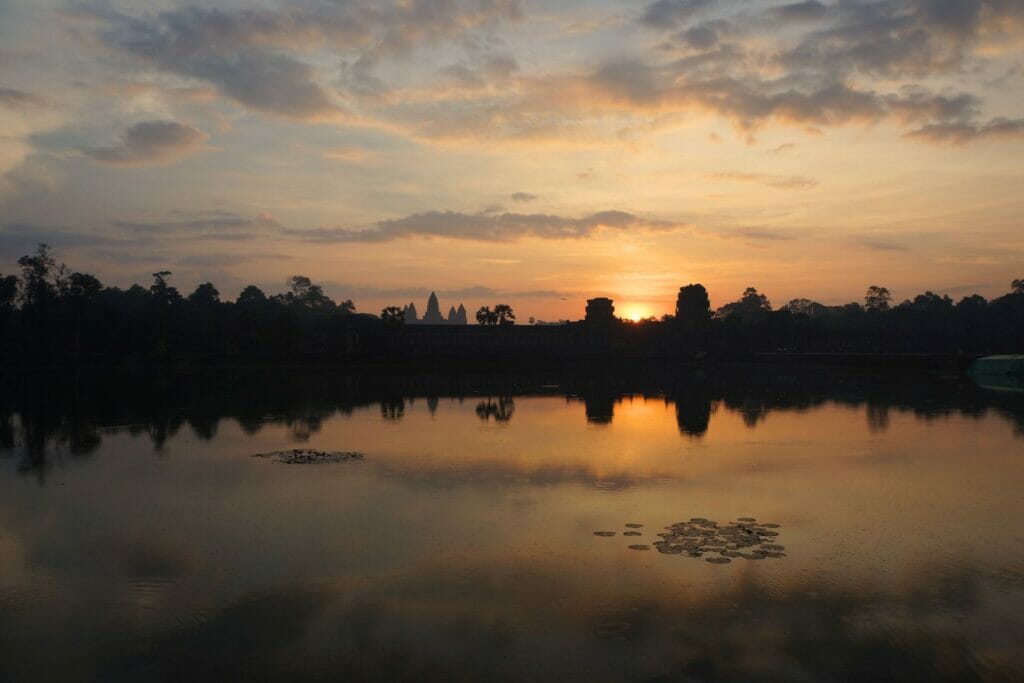
You can’t miss an Angkor sunrise! If the clouds have deserted the sky, expect an unforgettable spectacle! We’ve chosen to do it on just one day, but you can do it on all 3.
The most popular sunrise spot is undoubtedly the left (northernmost) basin in front of Angkor Wat. To get there, take the bridge, pass the west entrance and wait behind the basin. There’s no way you can go wrong – you’ll already see the crowds! Alternatively, you can observe it from the temple’s east entrance: you’ll see the walls slowly gilding and you’re sure to be alone!
If you still want to be away from the crowds, we advise you to watch it quietly from:
- Phnom Bakheng temple;
- Pre Rup, to the east;
- the bank of Srah Sang.
Angkor Thom and Bayon
After sunrise, don’t visit Angkor Wat just yet! Head for Angkor Thom and its famous Bayon before the crowds arrive.
You’ll see that the 216 enigmatic smiles of the Bayon are incredibly charming in the morning light, especially if you’re alone in the temple. There’s plenty of photo fun to be had on this site too! Then take advantage of the cool morning to visit the rest of Angkor Tom’s monuments: Baphuon, the Terrace of the Elephants, the Terrace of the Leper King, Phimeanakas temple…
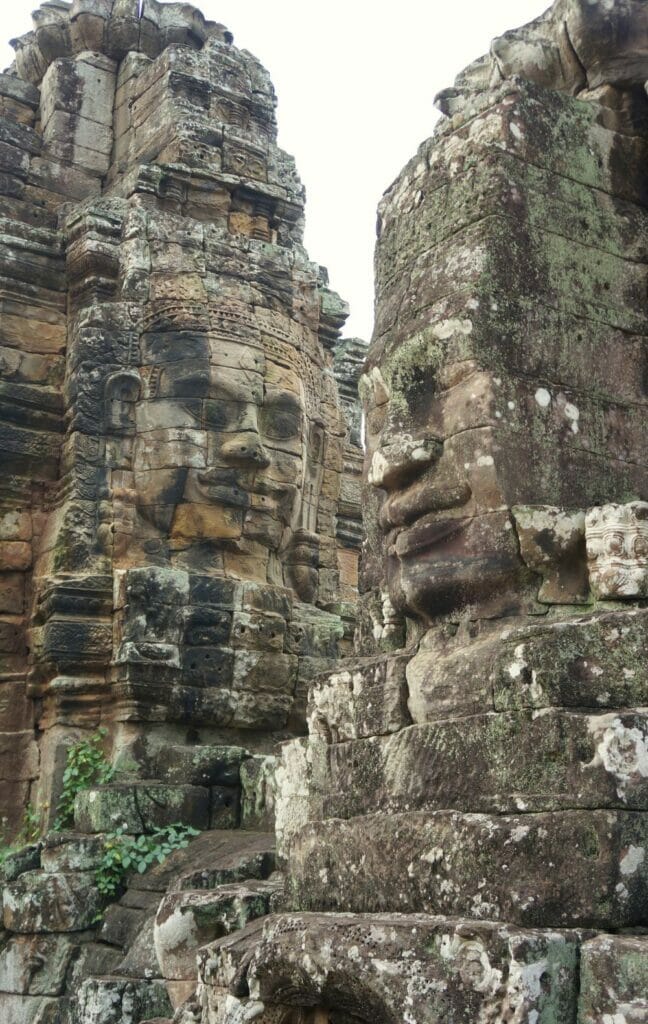
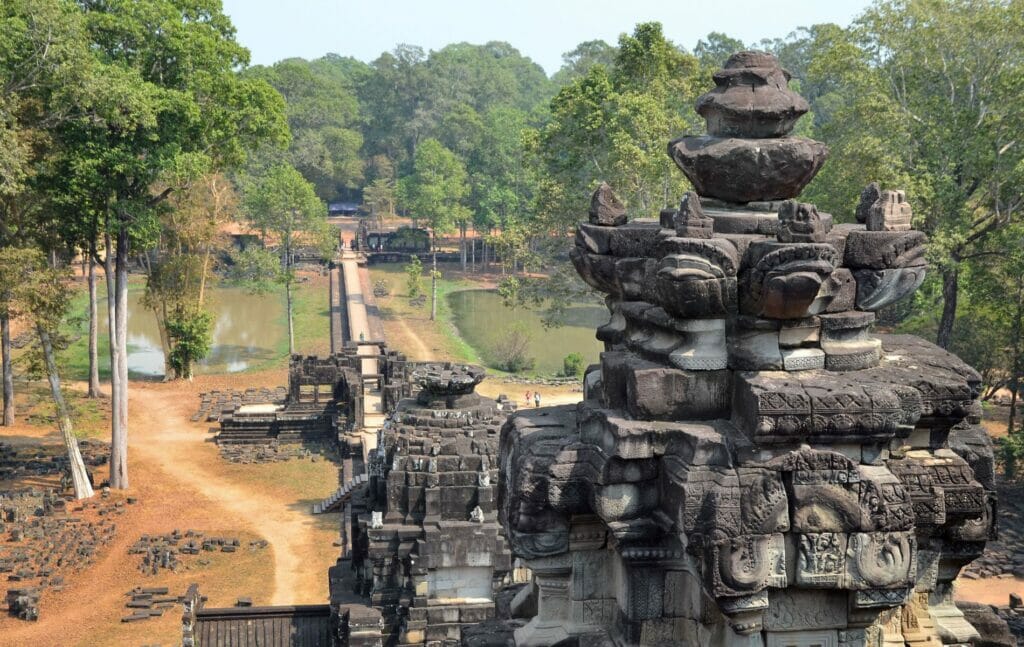
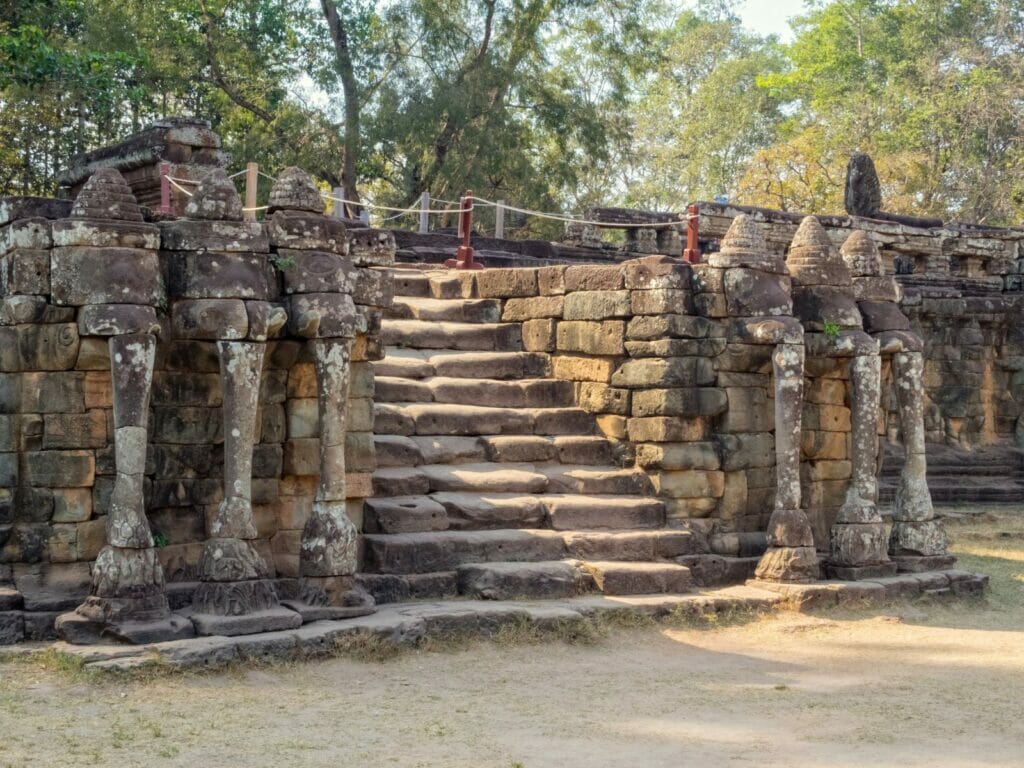
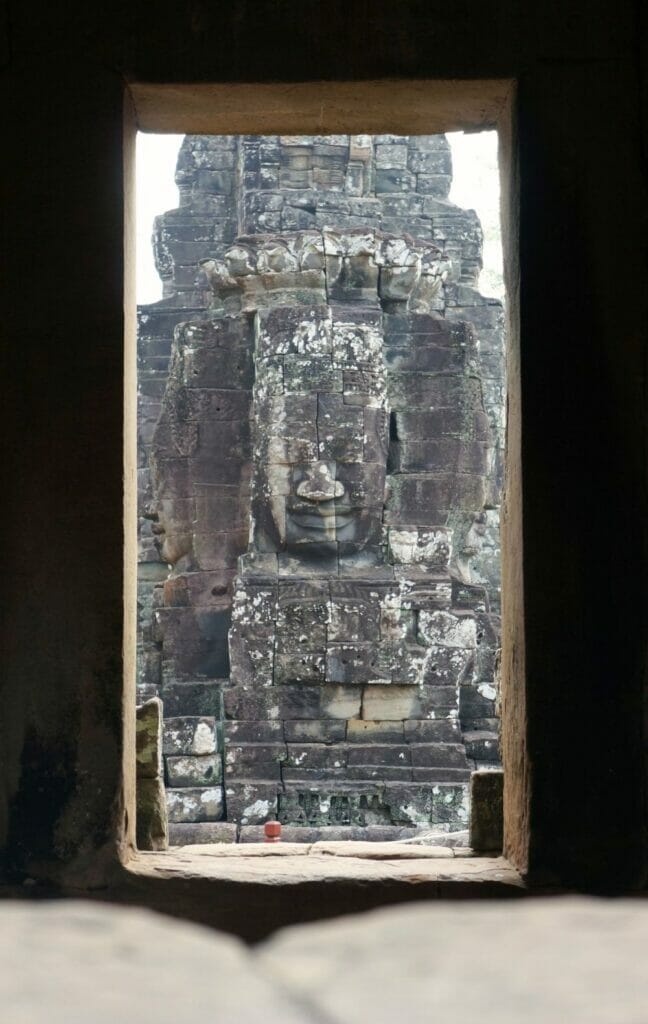
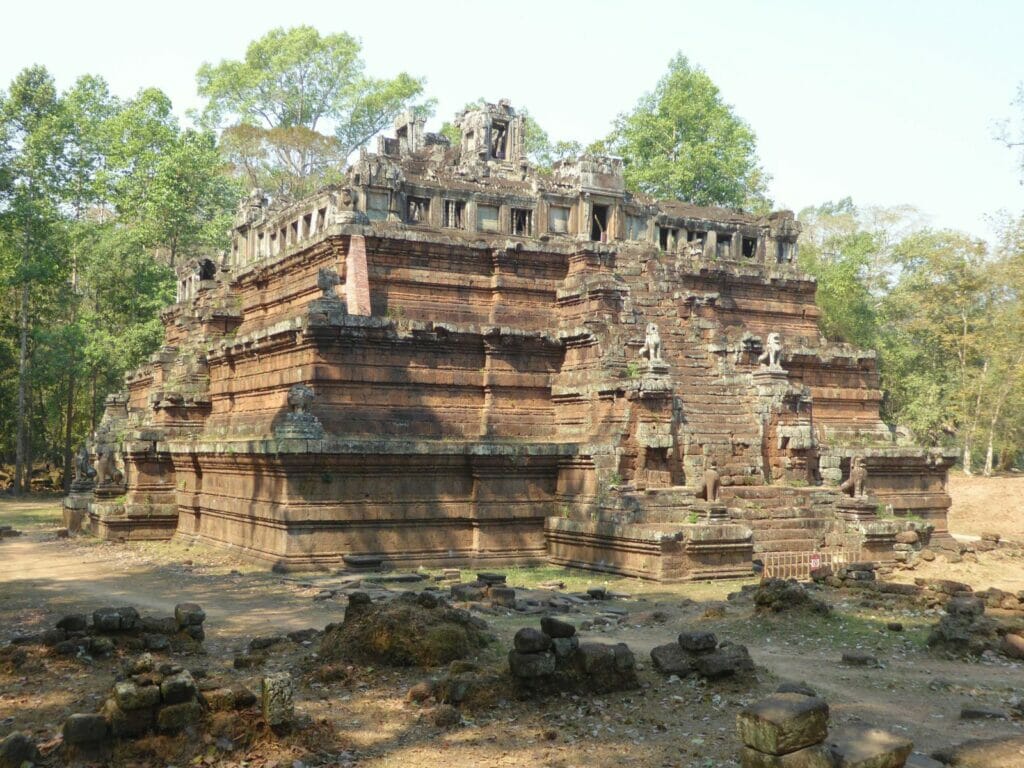
Ta Prohm and Banteay Kdei
If you run out of time on the first day, put yourself in Lara Croft’s shoes at Ta Prohm temple and then visit Banteay Kdei.
Angkor Wat and the sunset
Have we saved the best for last? You bet we have! Take advantage of lunchtime to visit the magnificent Angkor Wat temple. You’ll see that it won’t be crowded 😉.
Finally, to round off these 3 days of sightseeing through Angkor, don’t hesitate to get lost around the biggest temples and watch a final sunset (over Angkor Wat or elsewhere) if you feel like it!
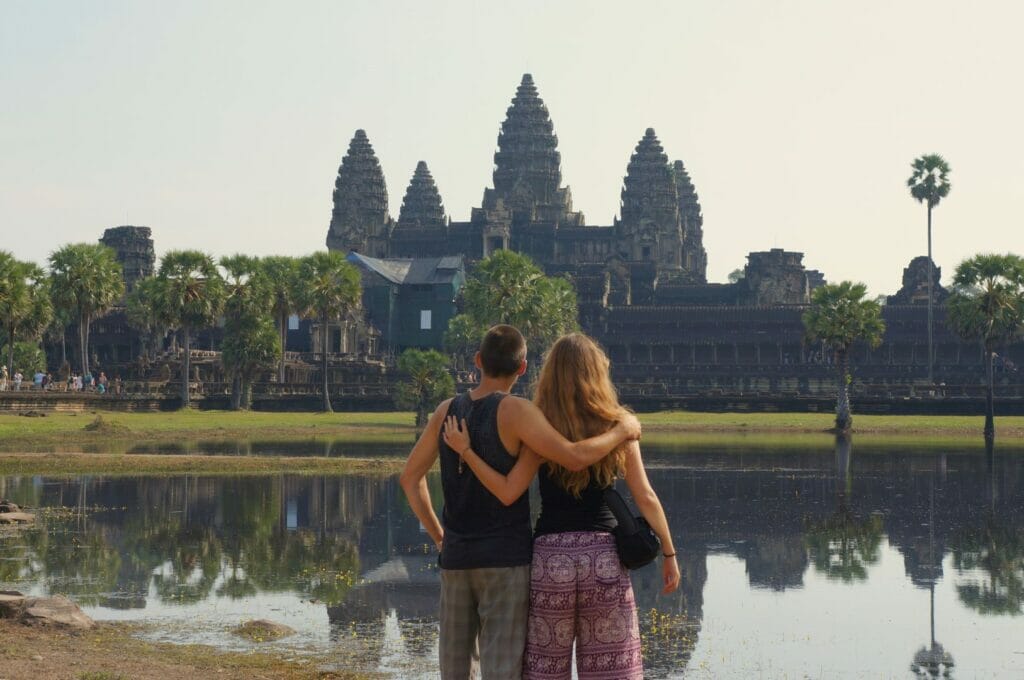
A few tips for visiting the temples of Angkor
- Get up early! Our itinerary may not be perfect, but it’s taking advantage of the early morning and lunch breaks to visit the main important Angkor temples.
- Always be one temple ahead of time for a leisurely visit, or do the loop counter-clockwise!
- Bring plenty of water: it’s hot, very hot in Angkor, and you’ll be gulping down at least 2 liters per person! And don’t forget your hat and sunscreen.
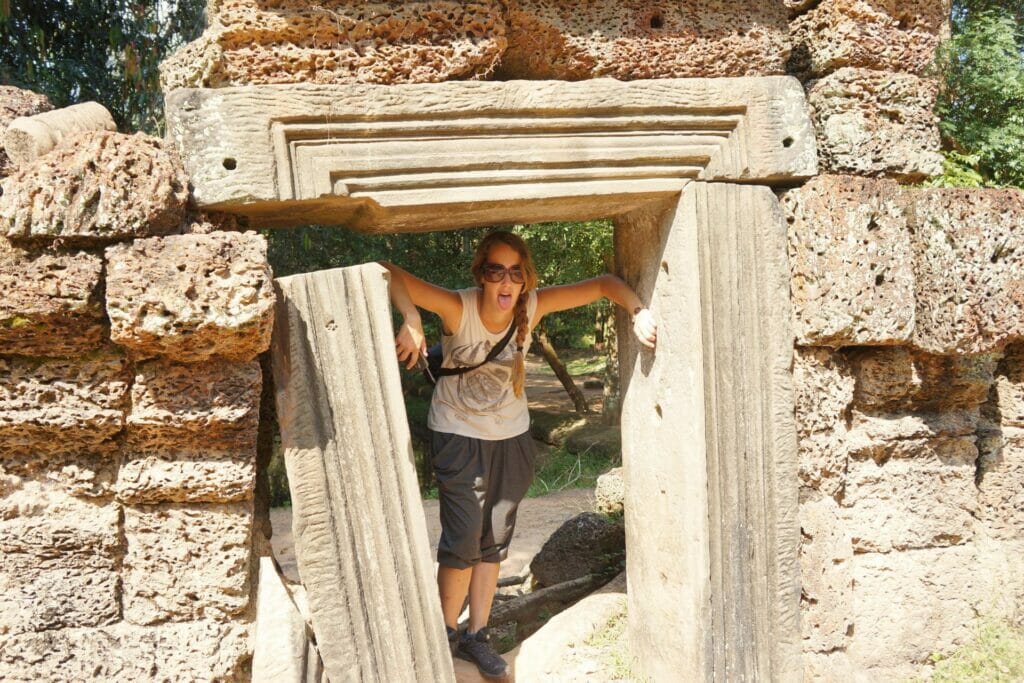
- Don’t forget your lunch! In any case, if you get up early, you’ll be hungry before noon. Then take advantage of the time when everyone’s eating to explore Angkor Wat temple. Make sure you have enough to eat: there are plenty of restaurants on-site, but we’re not sure you’ll get the best value for your money!
- Dress accordingly: even though it’s very hot, follow the dress code to respect the site. Cover your legs and shoulders as soon as you enter Angkor.
- Don’t hesitate to take a day off if you have time during your visit to Angkor. Doing it all in one go is the best way to have an overdose of temples, and that would be a shame.
- The best time to visit Angkor is during the dry season, from November to March. The weather may be less clement the rest of the year, but you’ll find far fewer people visiting the temples.
- Don’t be surprised: in Siem Reap, ATMs will give you US dollars, as everything is paid for in this currency!
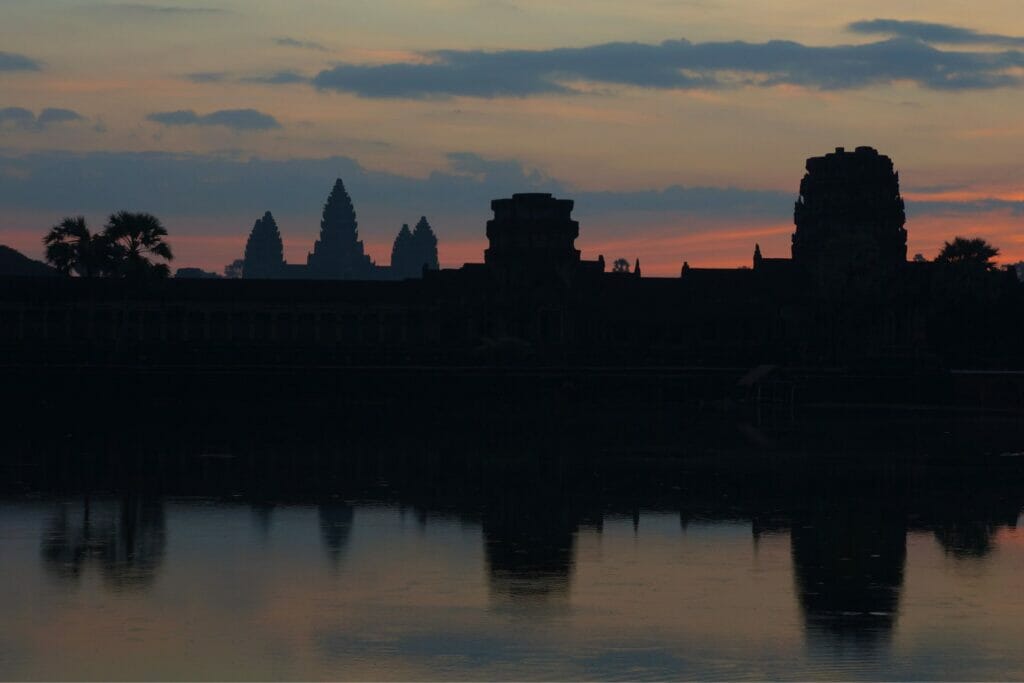
Are Angkor temples in danger?
One of the strengths (and weaknesses) of the city of Angkor is that you enjoy total freedom. You can enter every little corridor, explore every nook and cranny of every temple, touch the stones, and so on. This does come at a price, as you can see that the rock is wearing away in many places. At the same time, in a country as poor as Cambodia which depends mainly on tourism to survive (and therefore on Angkor, its main tourist site), it’s hard to imagine any government restrictions on visits.
Every year, several million tourists visit Angkor. In 2017, 5 million tourists visited Angkor, and at the time, 10 million were expected by 2025. But COVID has taken its toll on the tourism industry, which is struggling to get back on its feet. Especially since it was already declining before the pandemic began. In short, it seems that mass tourism has calmed down a little in Angkor. The reasons? Pass prices have risen, Bagan in Burma is attracting more and more visitors at Angkor’s expense, and Siem Reap is poorly served by direct flights. Will this respite be short-lived, despite the construction of the new airport? We hope not…
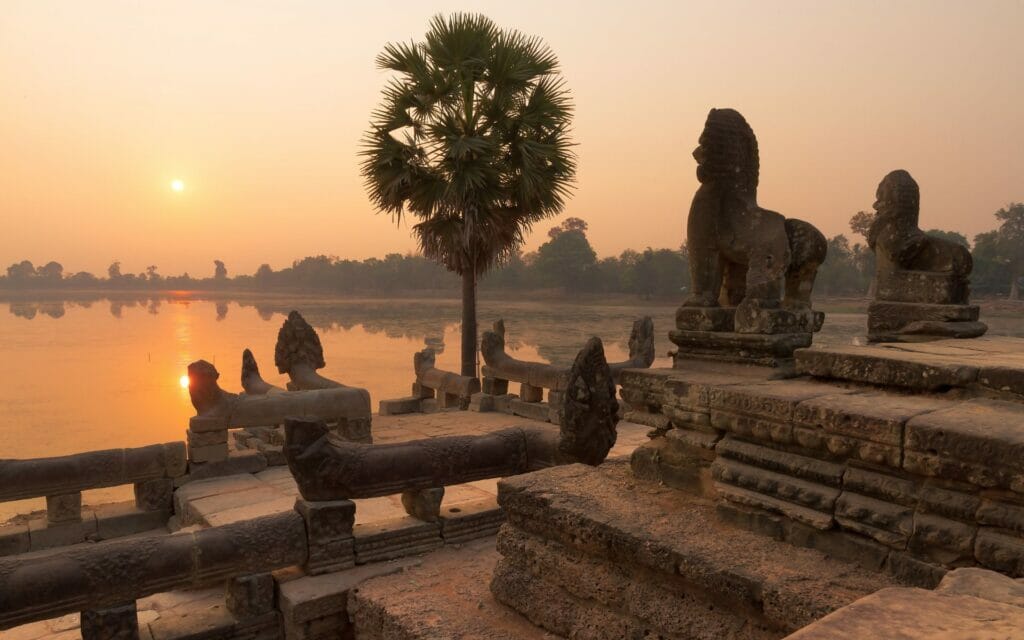
What to do in Siem Reap besides Angkor temples?
You’d think Siem Reap was all about the Angkor temples. Well, if you don’t want to discover the ancient royal city, then we don’t necessarily advise you to go to Siem Reap. Here, we’ve listed all the town’s places of interest, so you can kill two birds with one stone. After the Angkor temples, or while you’re on the road, take the opportunity to explore the rest of Siem Reap.
- Wander in Pub Street at dusk, the most festive and lively street in town.
- Take a Cambodian cooking class with the locals: after a trip to the local market, the cooking class allows you to prepare and taste 4 dishes, including the must-try Tom Yum. The minimum price is 18 euros per person. We took one in Phnom Penh and thoroughly enjoyed the experience!
- Opt for a food tour if eating is more your thing than cooking! A guide will take you to taste the essence of Cambodian cuisine.
- Enjoy Cambodian food! I promise this is the last time we’ll talk to you about food! But we have to admit that Siem Reap is a real paradise for foodies. In fact, a reader recommended the Bayon Coffee Shop Siem Reap, in the town center. This NGO has set up a pastry school that trains underprivileged young women for future employment. They then go on to work as interns in the major hotels in the area. In this café, you can sample the delicious cakes made by the students. In short, a great address for breakfast or a snack break after visiting Angkor!
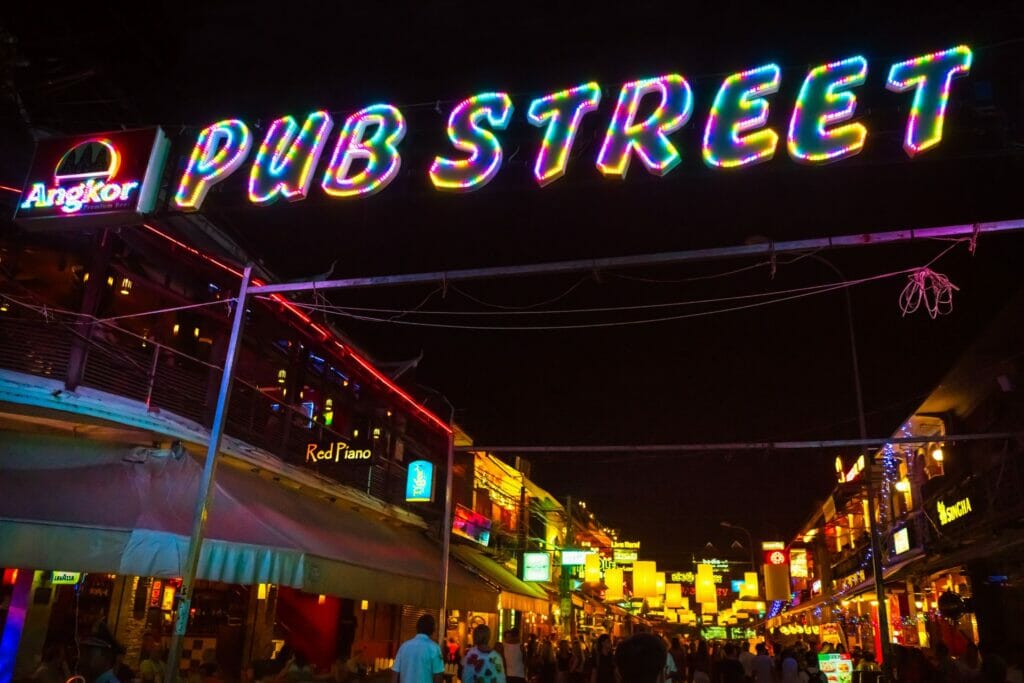
- Stroll through the Made in Cambodia market to discover Cambodian handicrafts while eating in the street.
- Attend a Phare Circus show, a clever blend of theater, circus and dance. We recommend this venue rather than the Apsara Theater, which is a bit of a tourist trap… Tickets start at 16 euros for general admission.
- Walk through the tree-lined avenues of Siem Reap’s Botanical Garden: if you’re looking for a peaceful place to escape the hustle and bustle of tourism in the region, then the Botanical Garden is a good choice. What’s more, admission is free!
- Visit the Angkor National Museum: if you decide to visit the temples of Angkor on your own without a guide, a visit to the museum beforehand will give you the information you need to better appreciate your discovery of Angkor and its rich history! The museum is open all year round from 8.30 a.m. to 6 p.m., and tickets cost 12 euros. Audioguides are available from reception for 5 euros.
- Learn pottery in a 2-hour class, where you’ll learn the basics before setting out to make your own object.
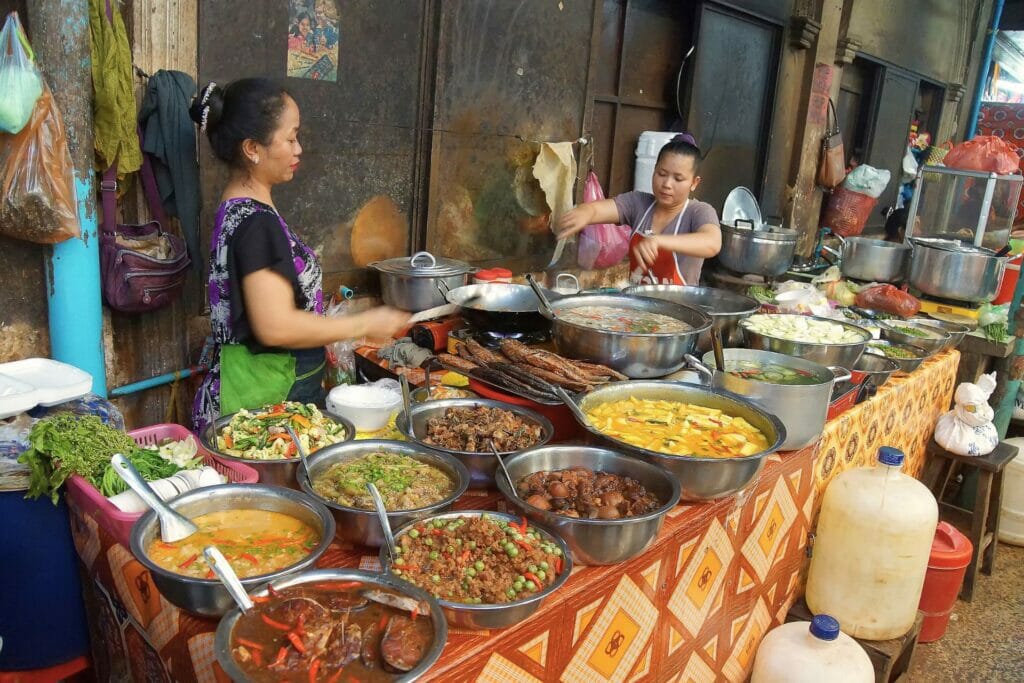
What to do around Siem Reap?
If you’re planning to stay in Siem Reap for more than 4 days, this could be the perfect opportunity to explore the surrounding area.
- Hike in Phnom Kulen National Park, 2 h from Siem Reap: admire the eponymous waterfall and the pretty Peam So Hoh waterfall (more impressive).
- Explore other temples: Koh Ker is also worth a look, with its Inca pyramid look. Located a little further away than Phnom Kulen Park, you’ll be far from the crowds. Admission costs $15. Beng Mealea looks like Ta Prohm, and you’ll probably be the only visitor to this temple lost in the middle of nature. The price is included in your Angkor pass.
- Visit the floating village of Kompong Phluk (or Kampong Phluk) near Tonle Sap Lake: the easiest way is to hire a guide to take you from Siem Reap. You’ll avoid scams and learn about the daily life of the Cambodians living in these dwellings on the water. The best time to visit is during or after the rainy season. During the dry season, you may not get very far by boat…
- Discover the surroundings by bike: come on, admit it, you still feel like pedaling after doing Angkor by bike 😉? I promise this ride through the Cambodian countryside should be less strenuous than the tour of the royal city!
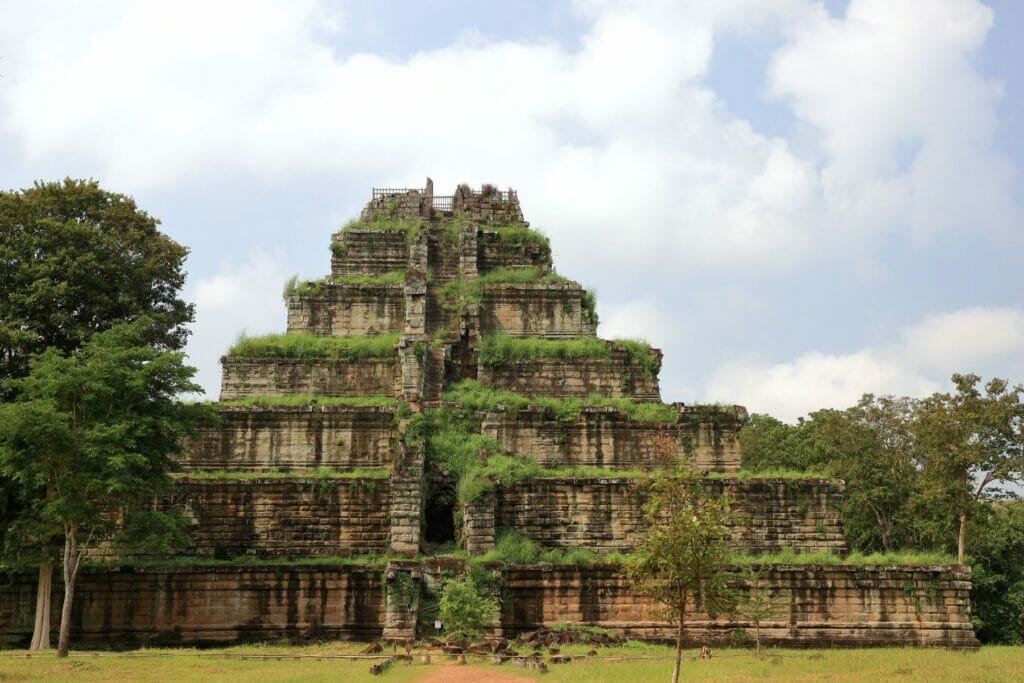
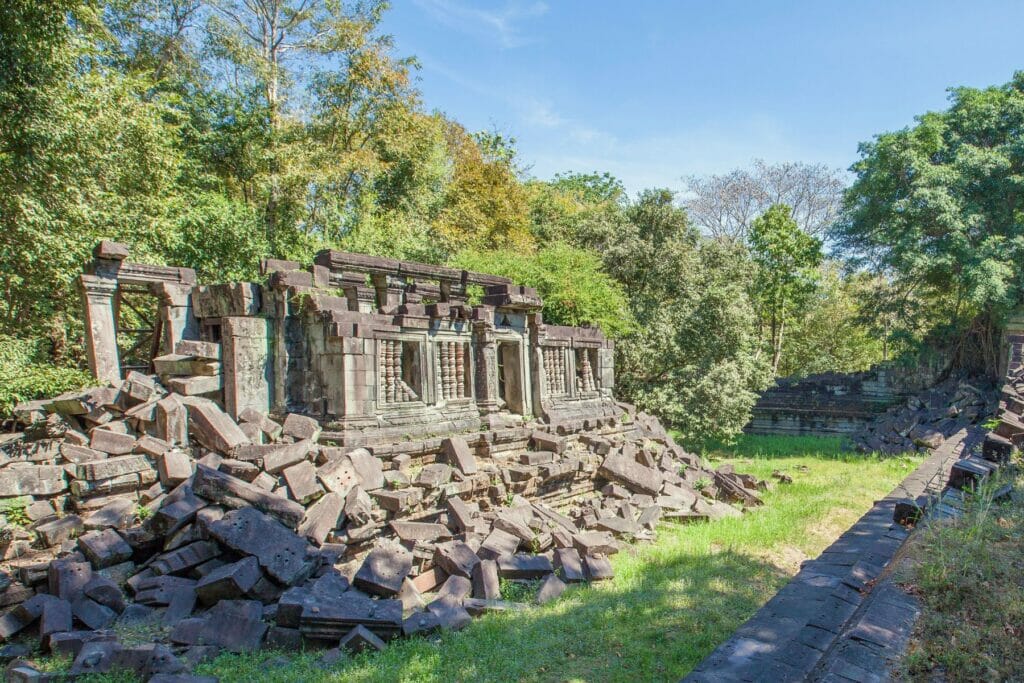
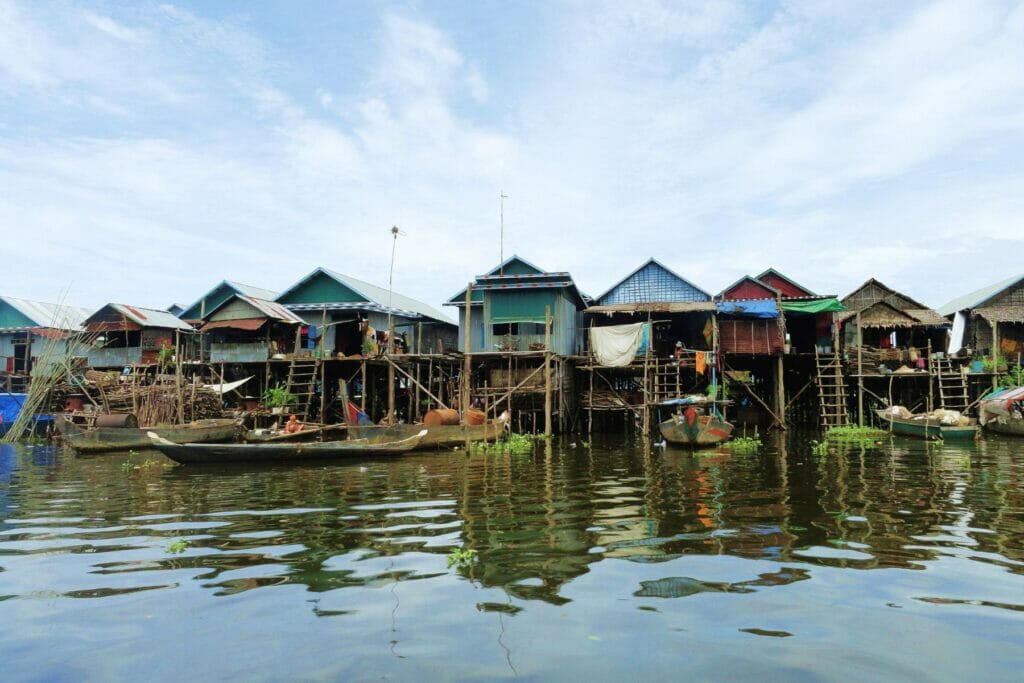
In conclusion, the temples of Angkor are just incredible, but for how much longer? Time will tell… If you’ve visited Angkor recently, let us know in the comments what you thought! For us, the trip to Cambodia continues: off to the capital, Phnom Penh!
Pin it
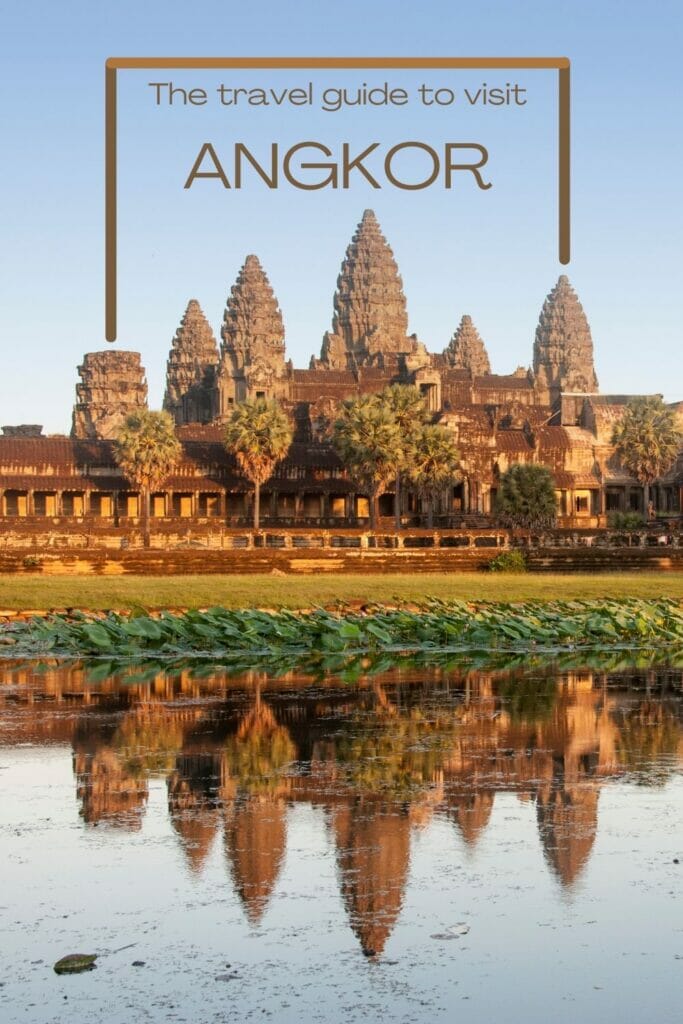
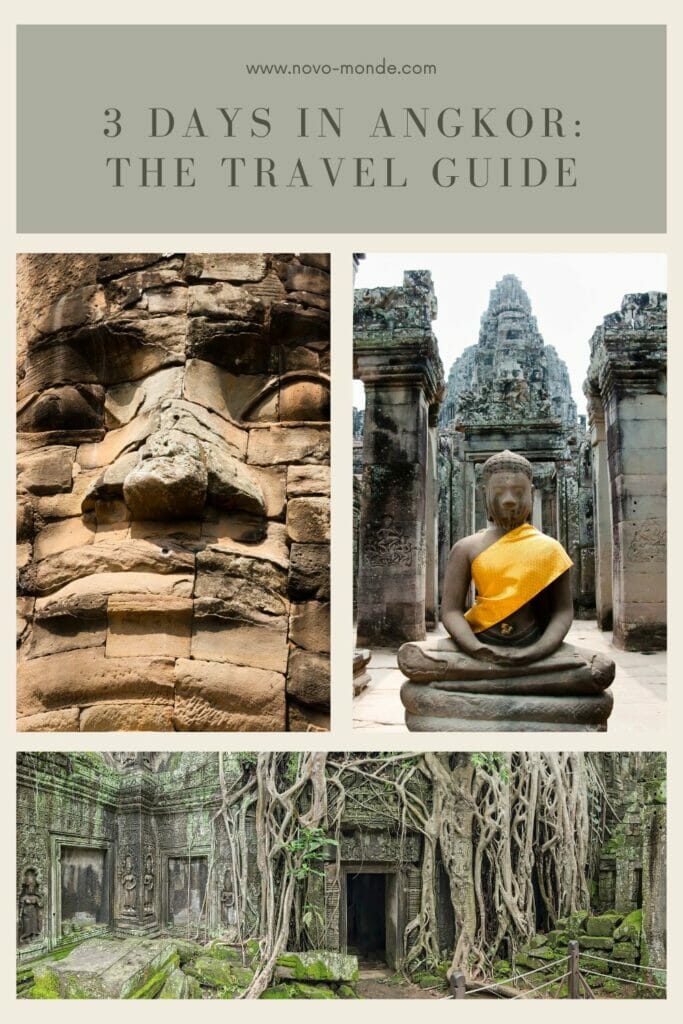
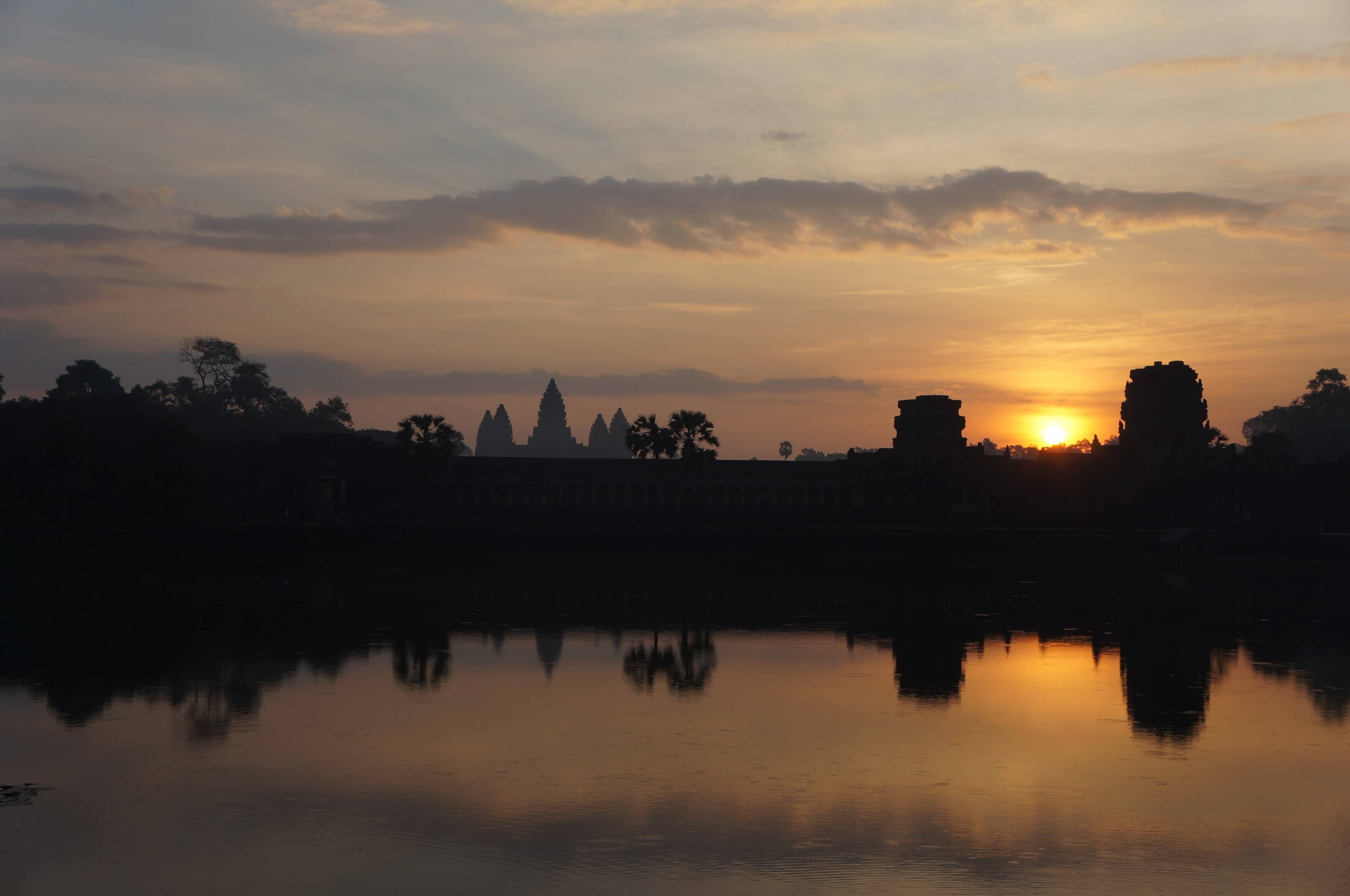
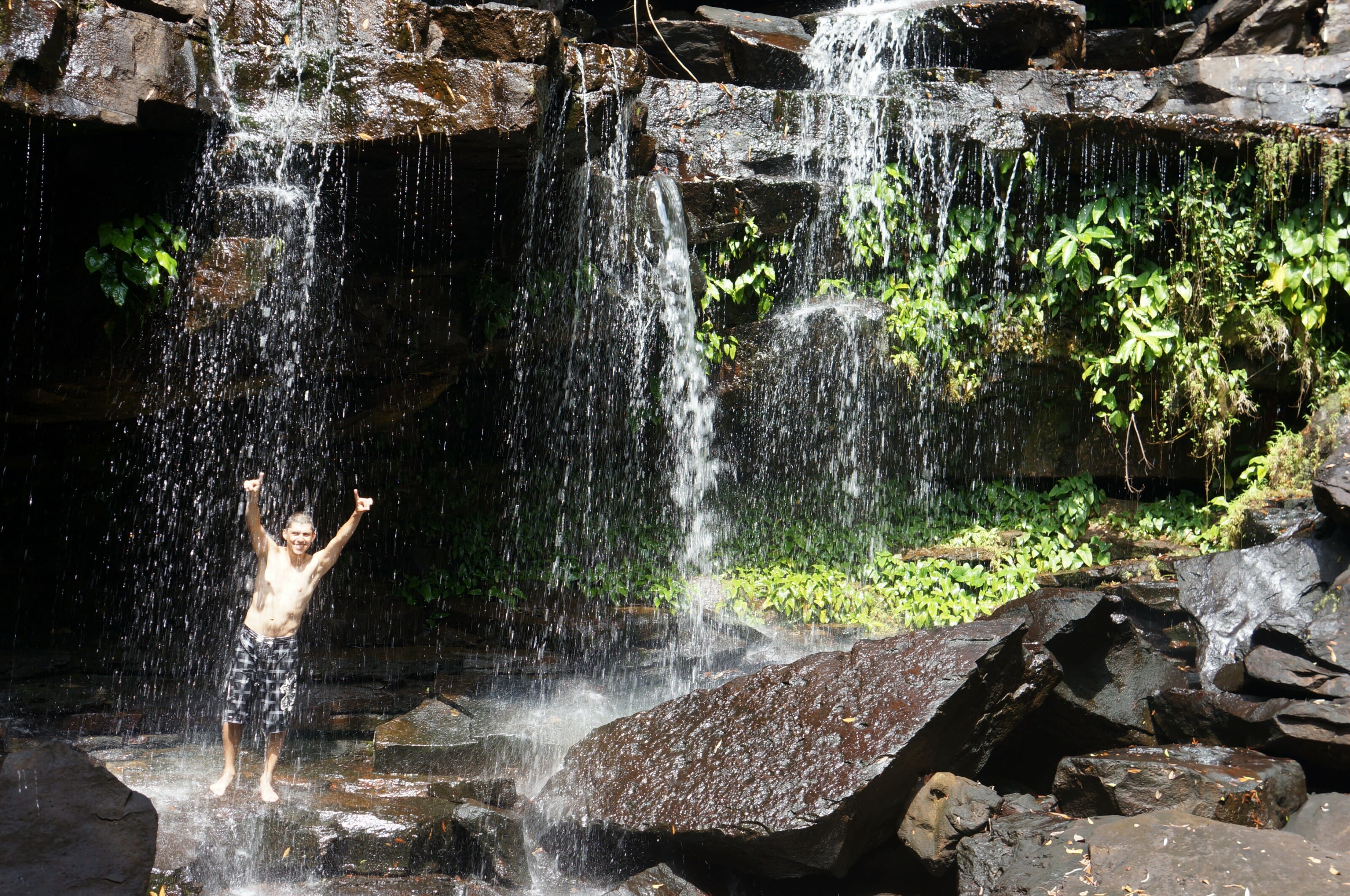
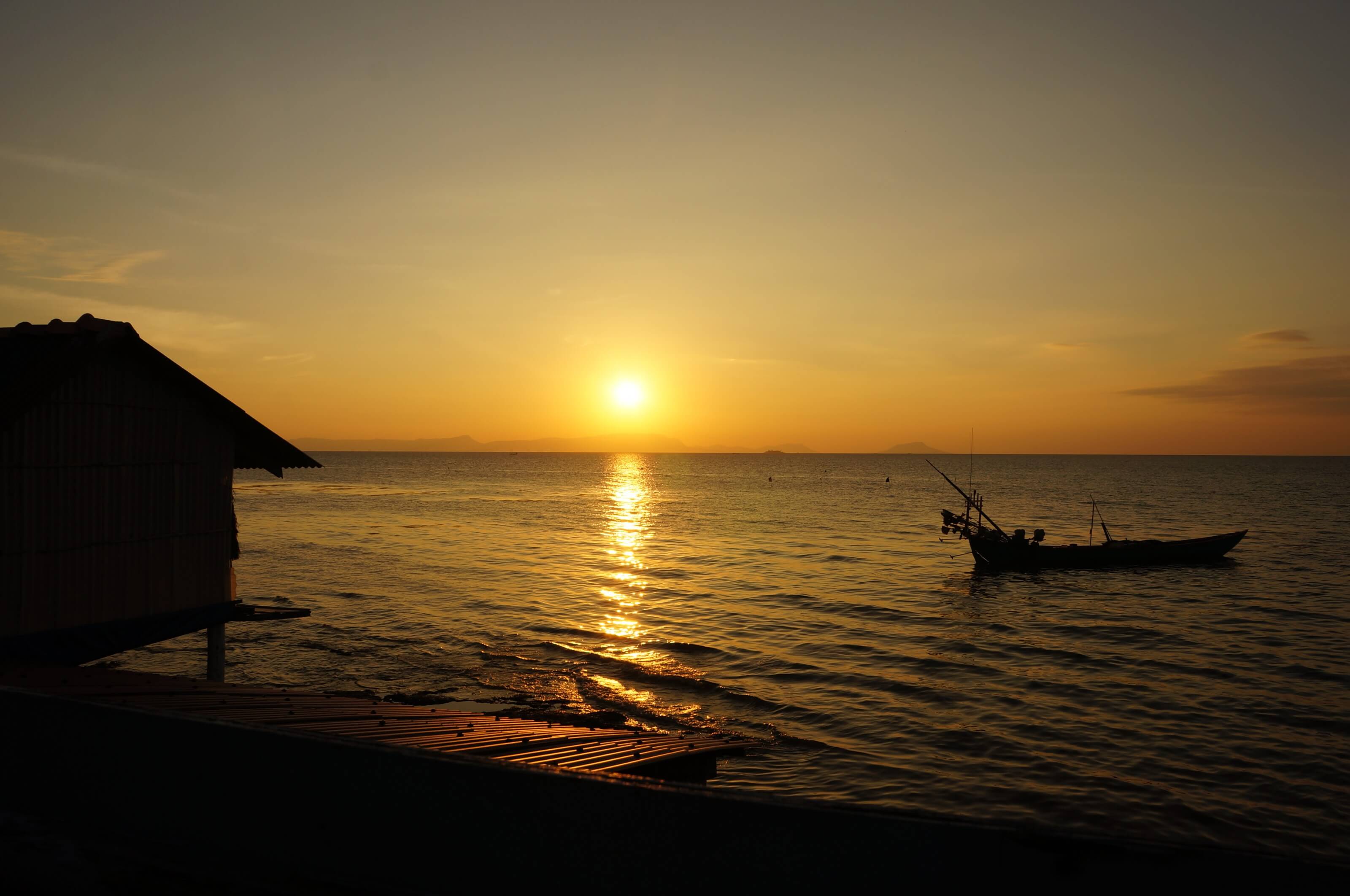
Thank you for sharing the rec for Ms. Kim the tuk tuk driver! We messaged her and she drove us around during our three day stay in Siem Reap and absolutely loved it! Would highly recommend to everyone who visits!
Amazing itinerary it was super helpful for us in navigating all the temples in Siem Reap and getting a quick history lesson on them! And we found out about Miss Kim through your blog and couldn’t be happier!! She was such a joy and the best tuk tuk driver we could have asked for!!
Thank you for helping me plan the perfect trip to the temples. Your itinerary is so easy to understand and navigate. 😍
Glad it helped Joe 🙂